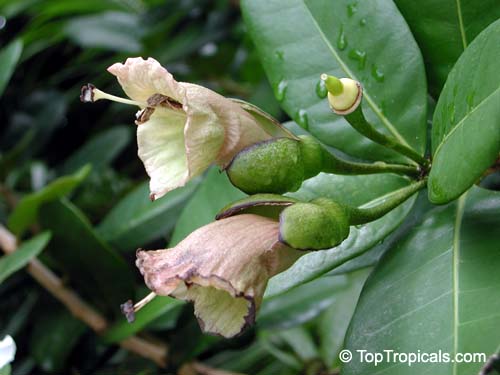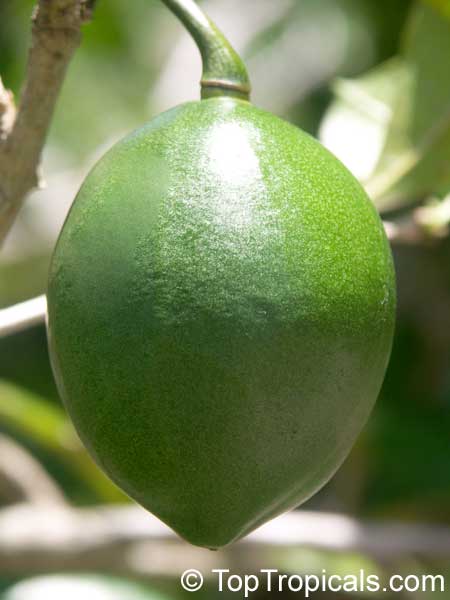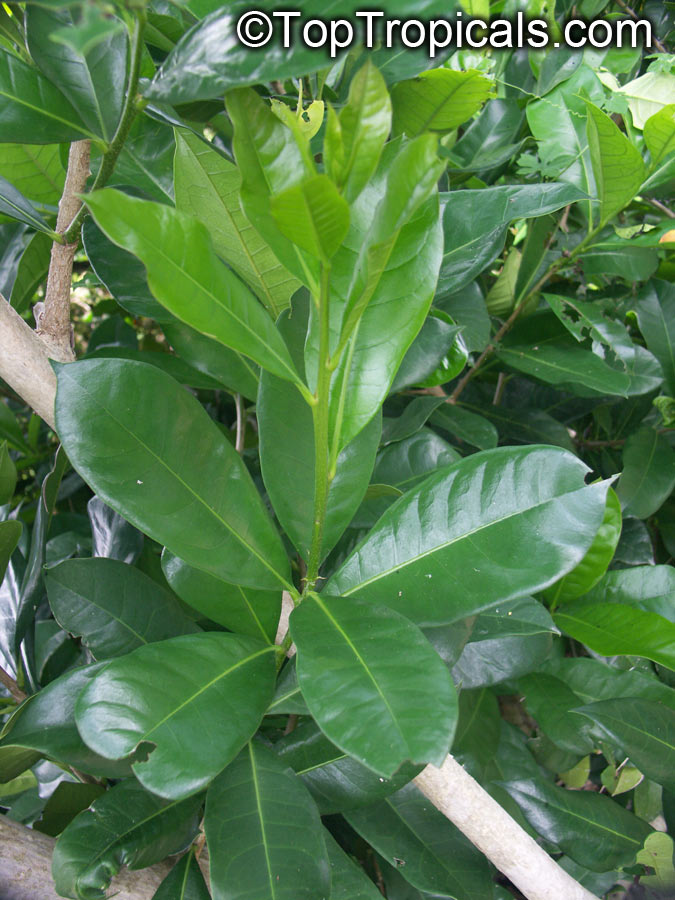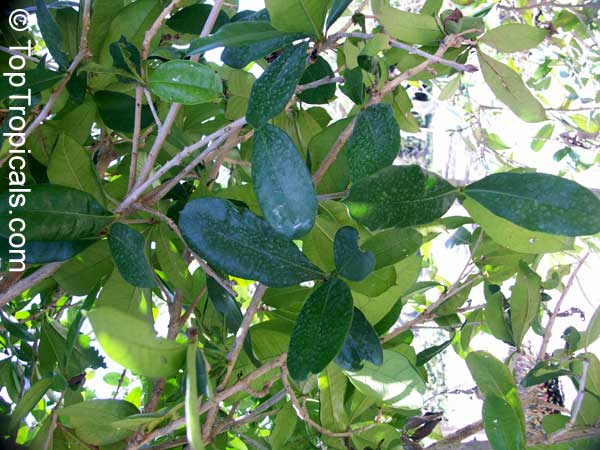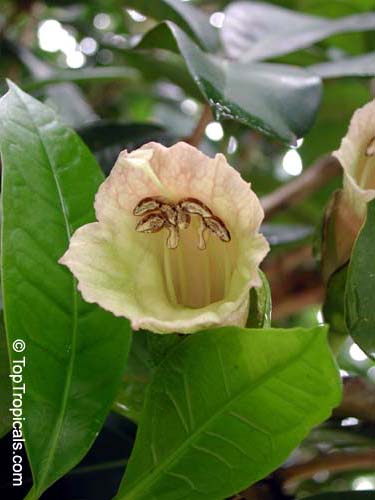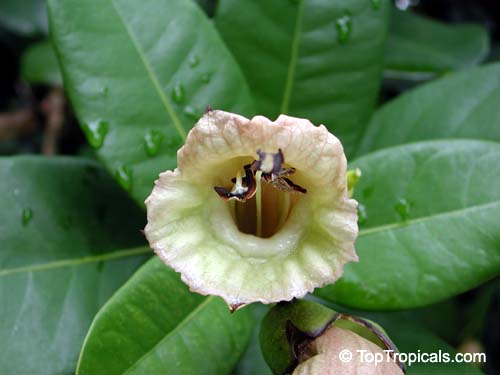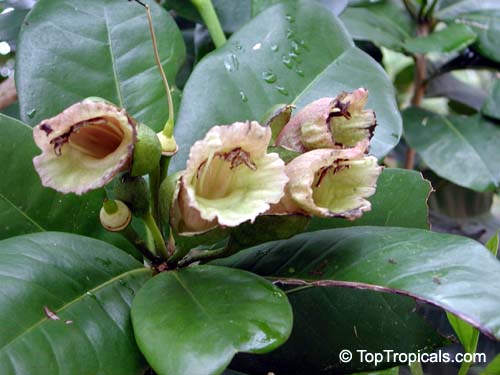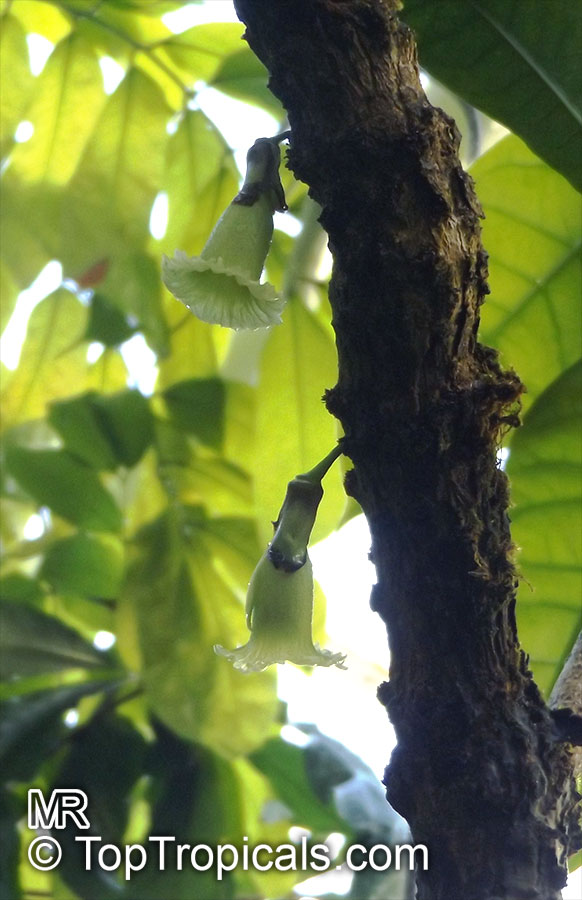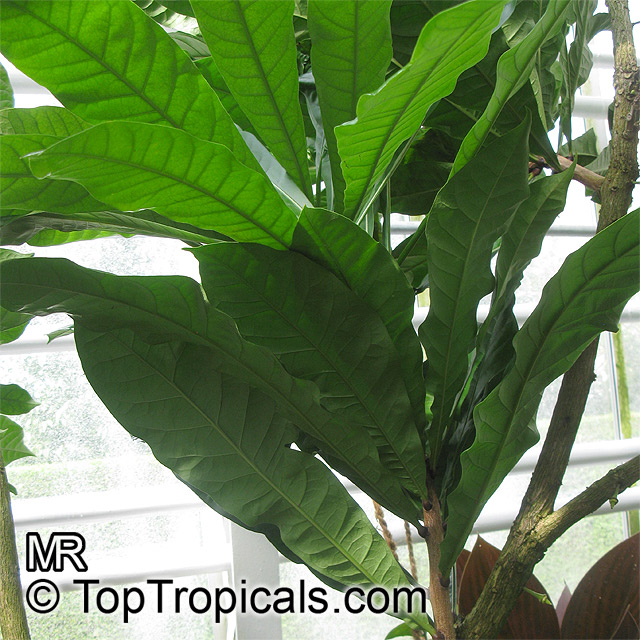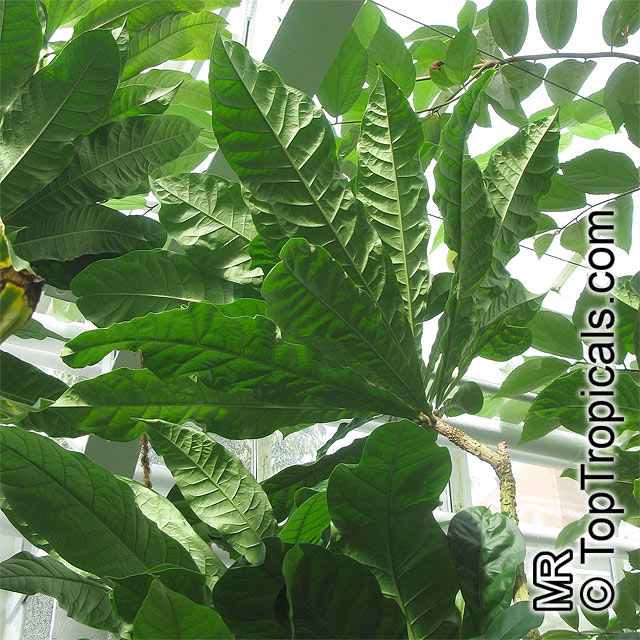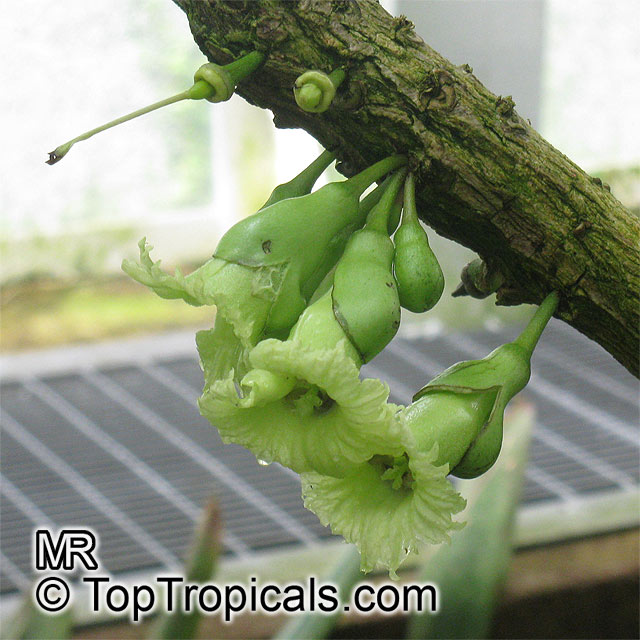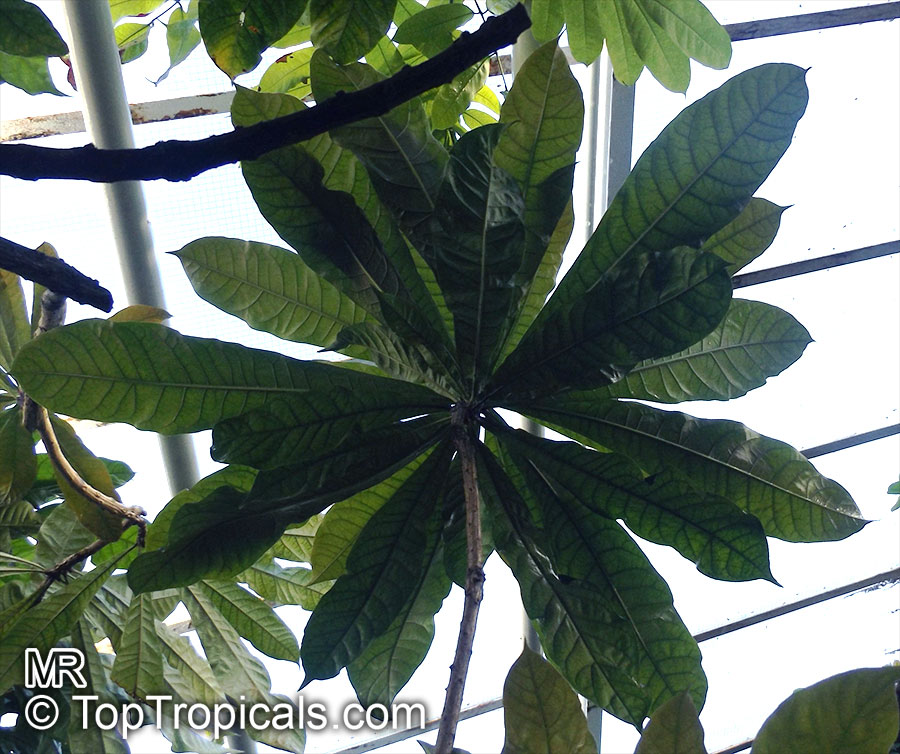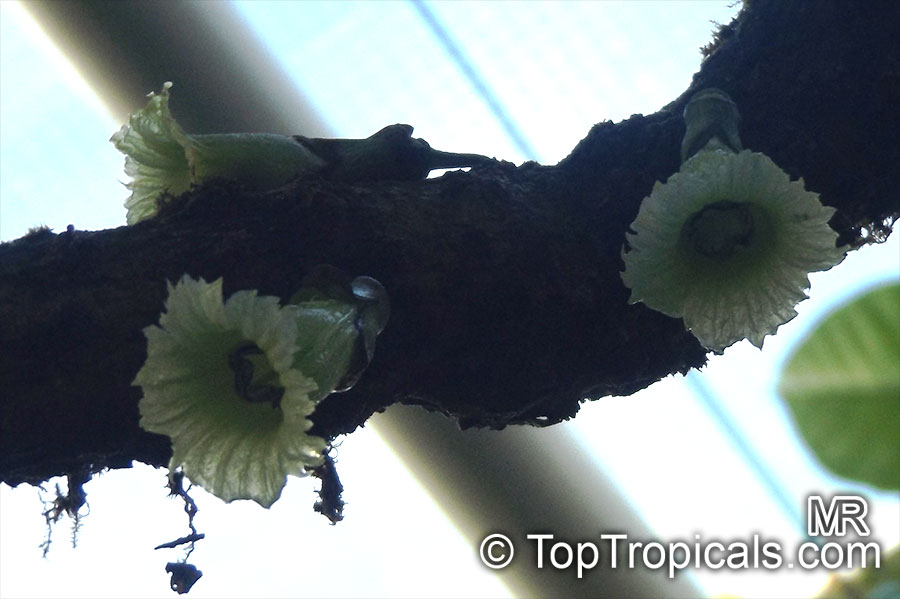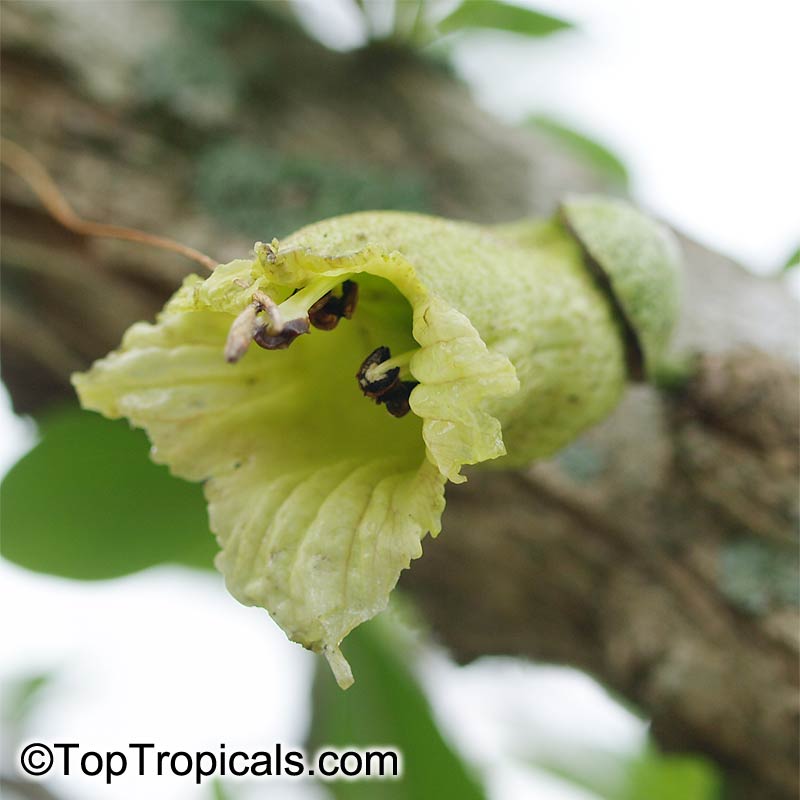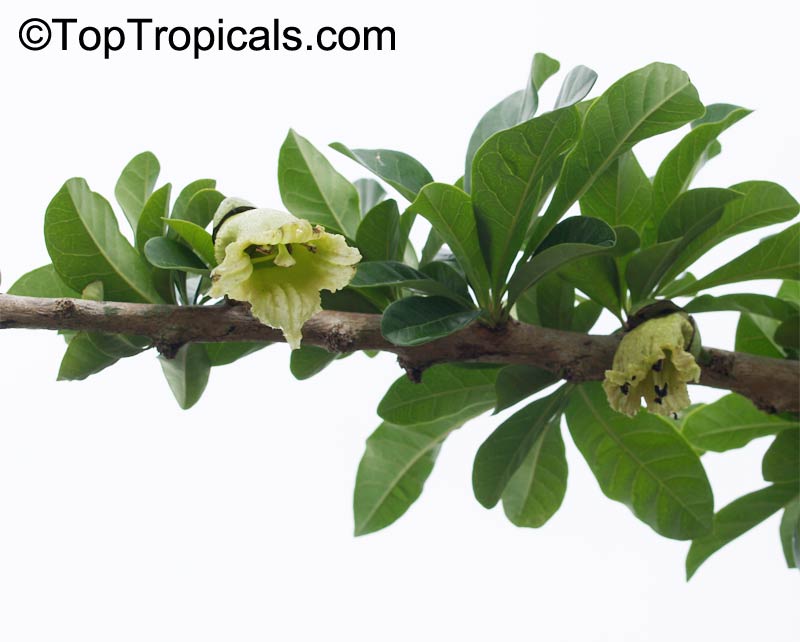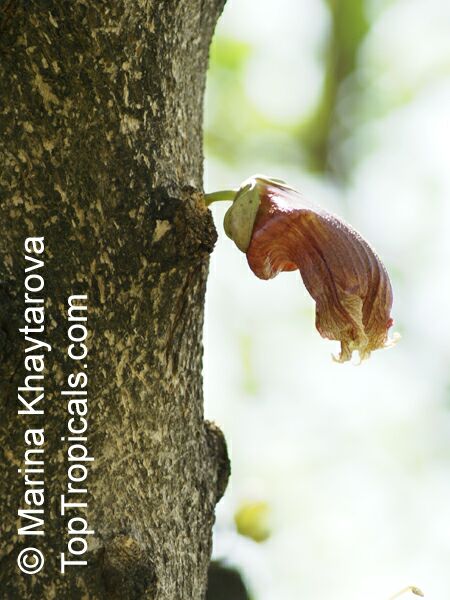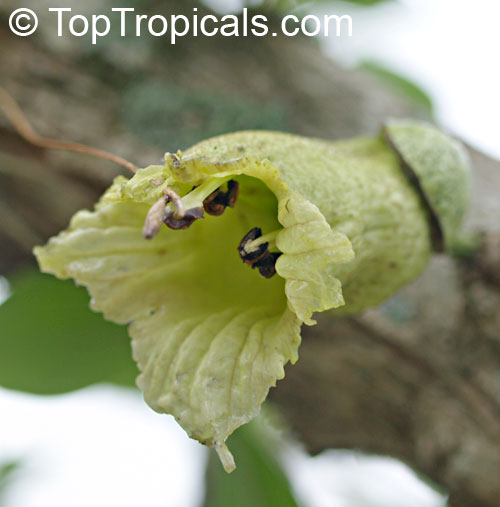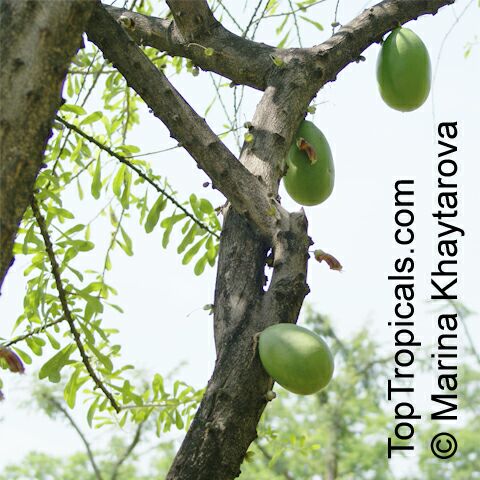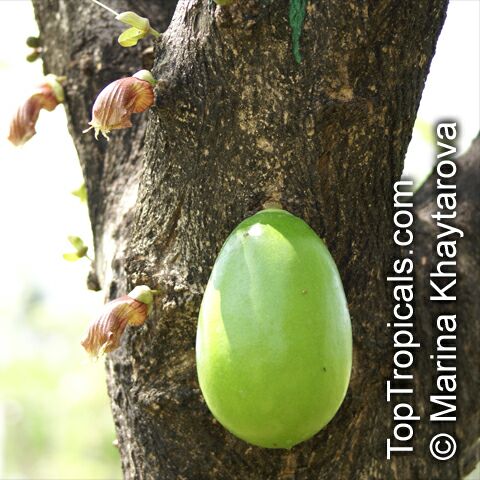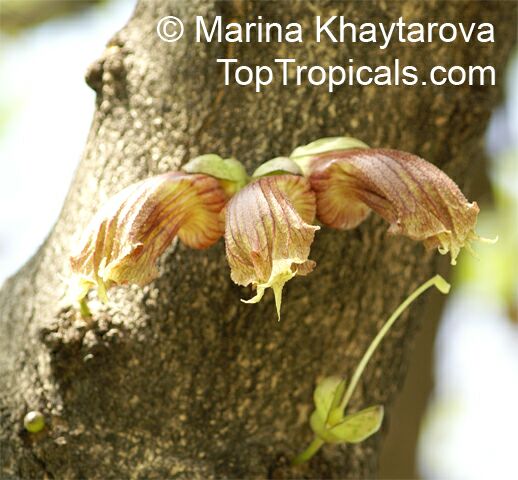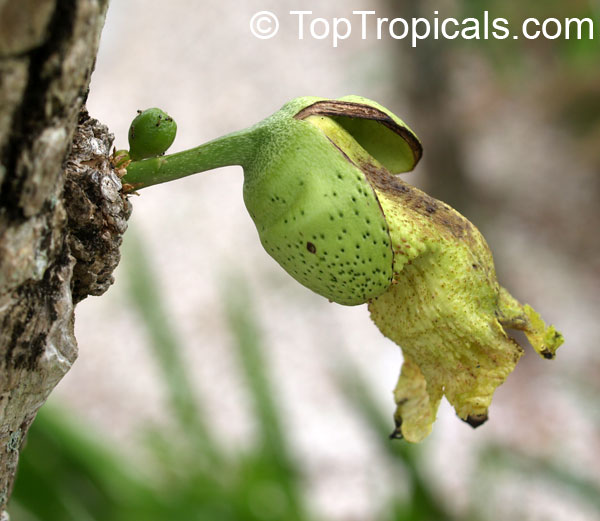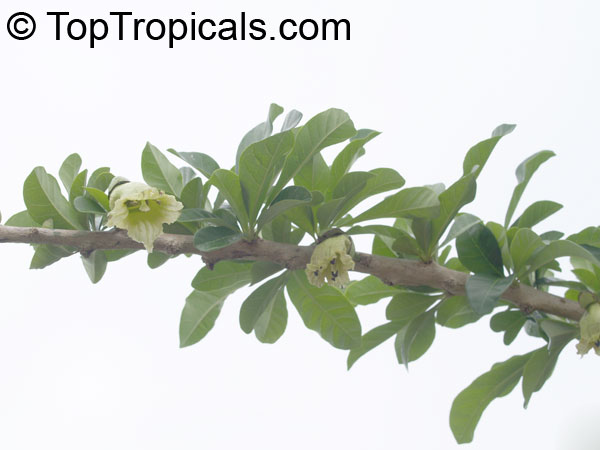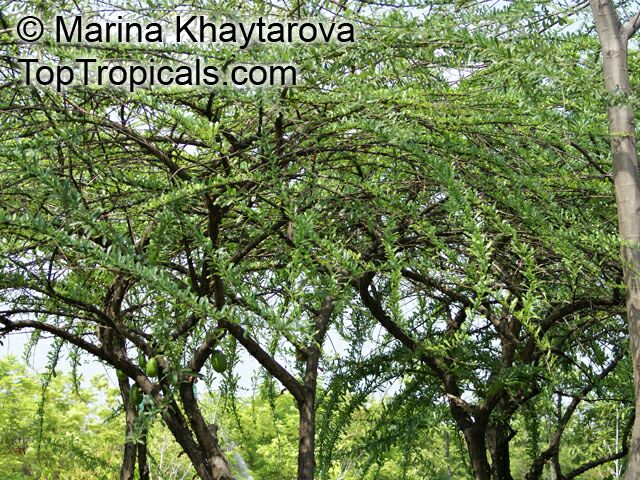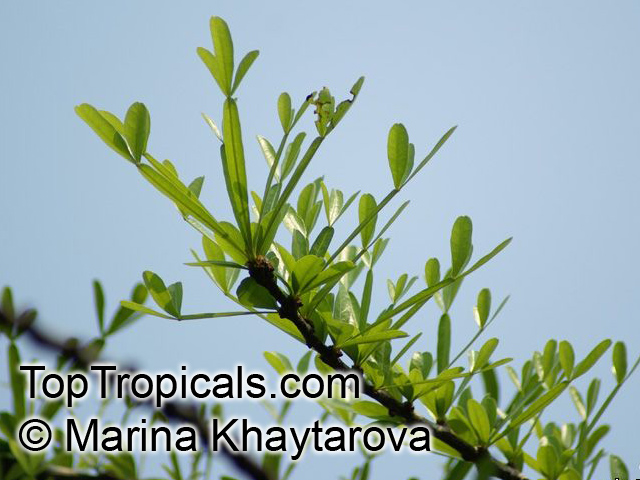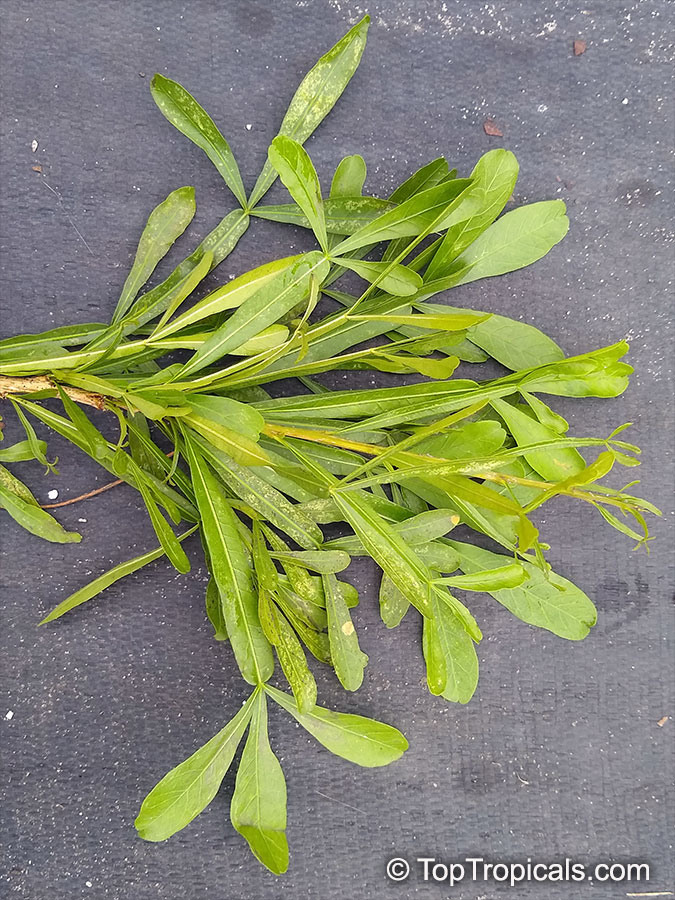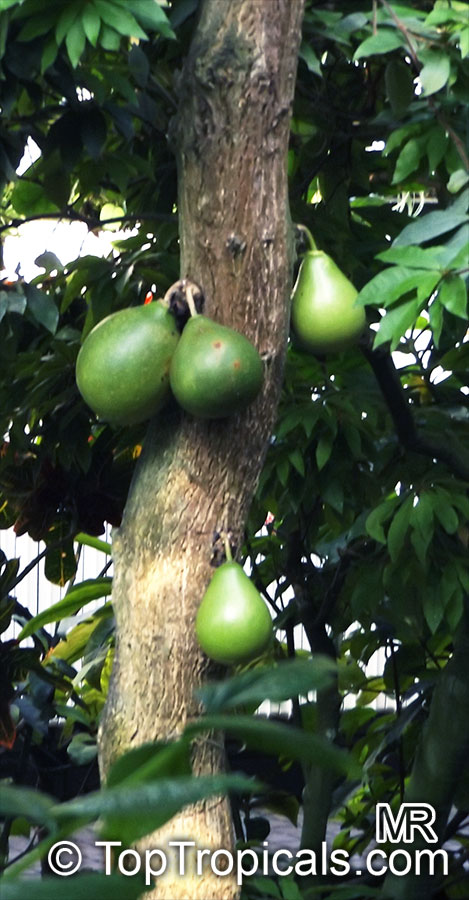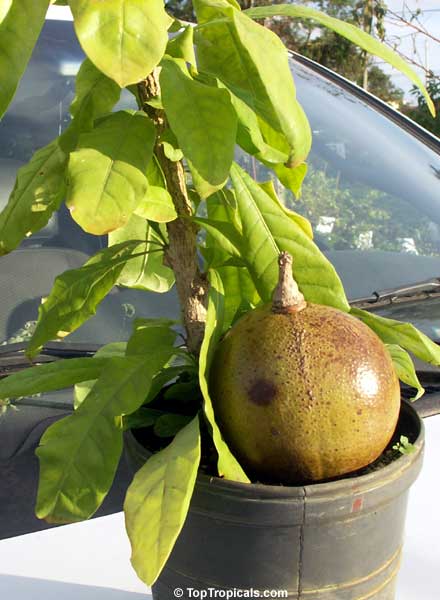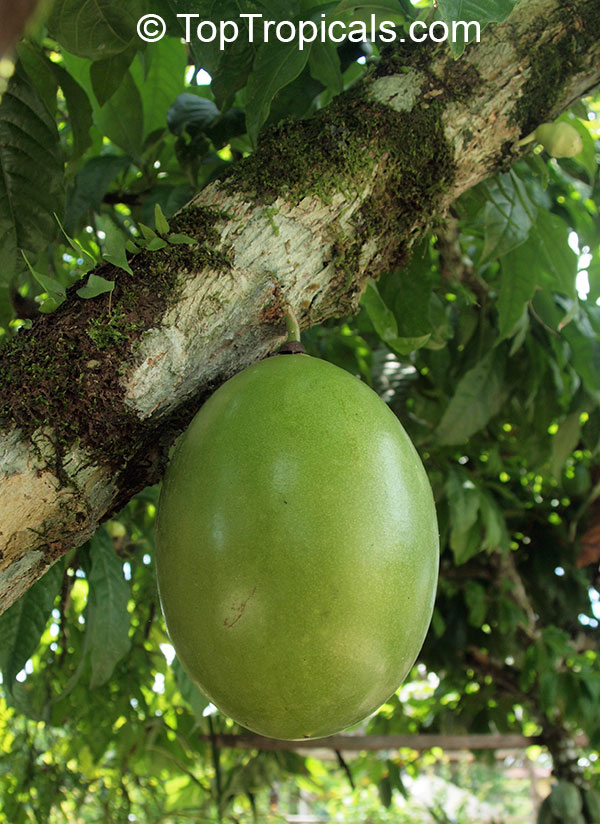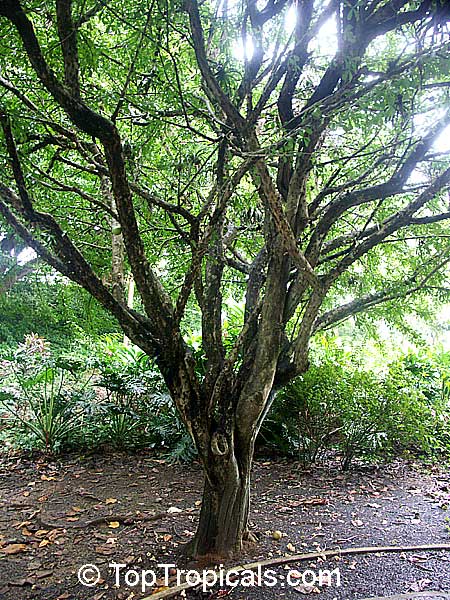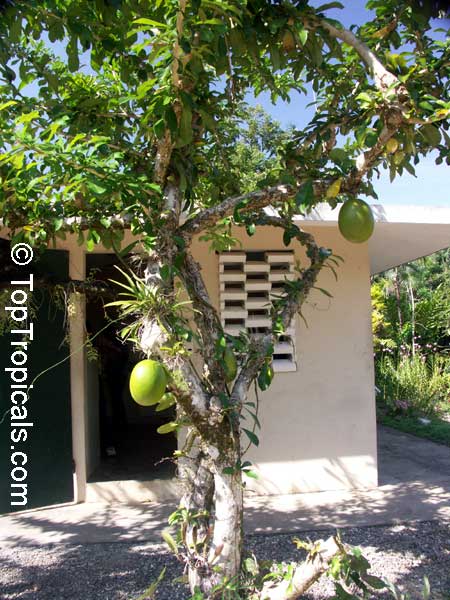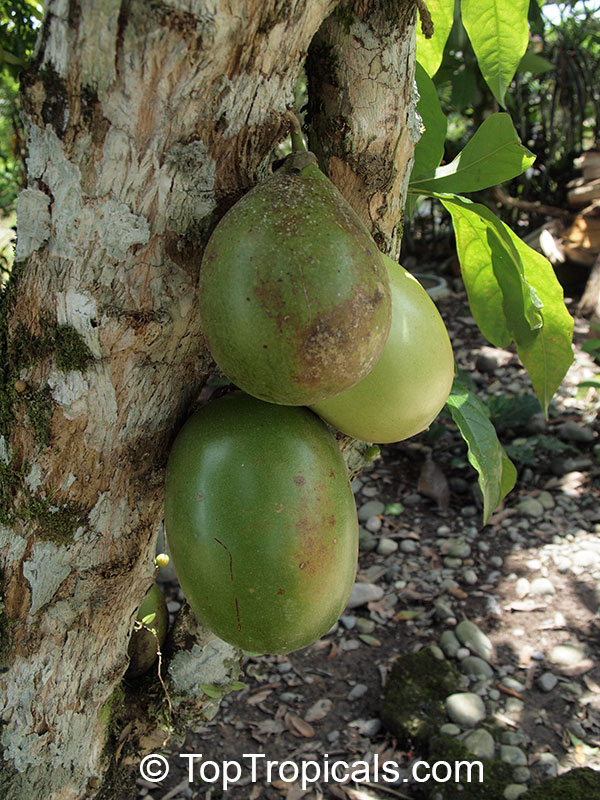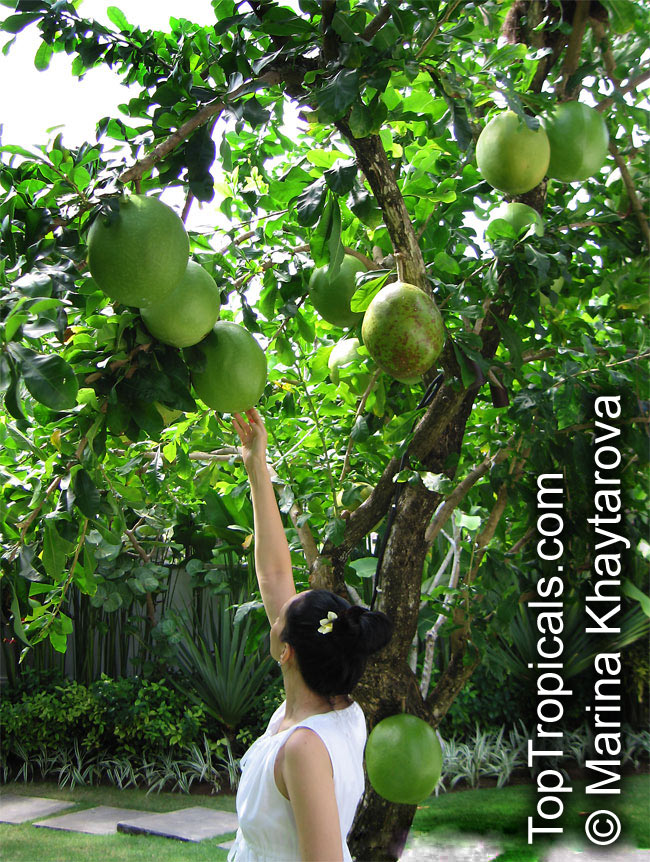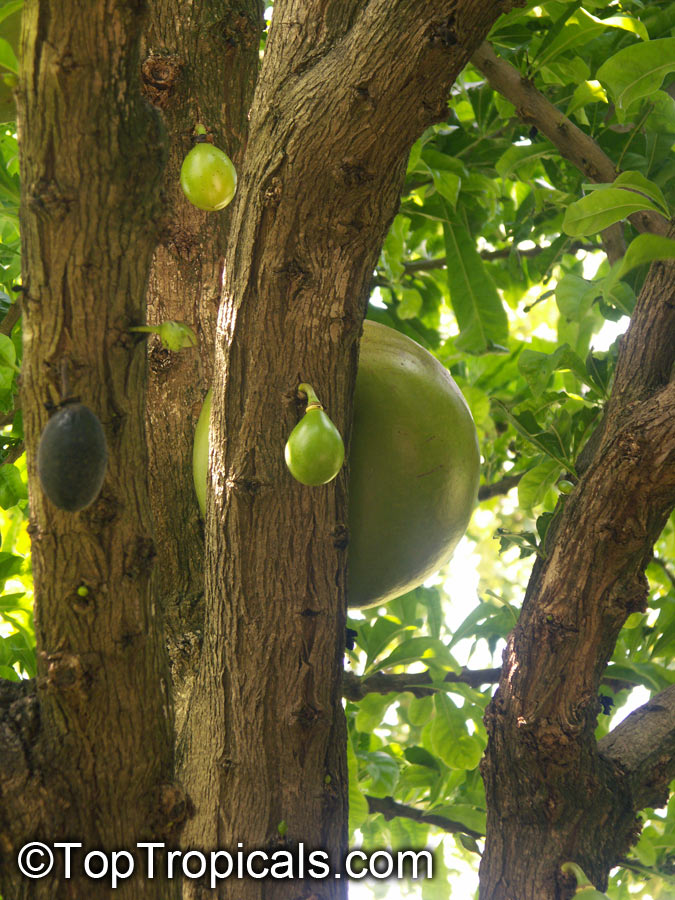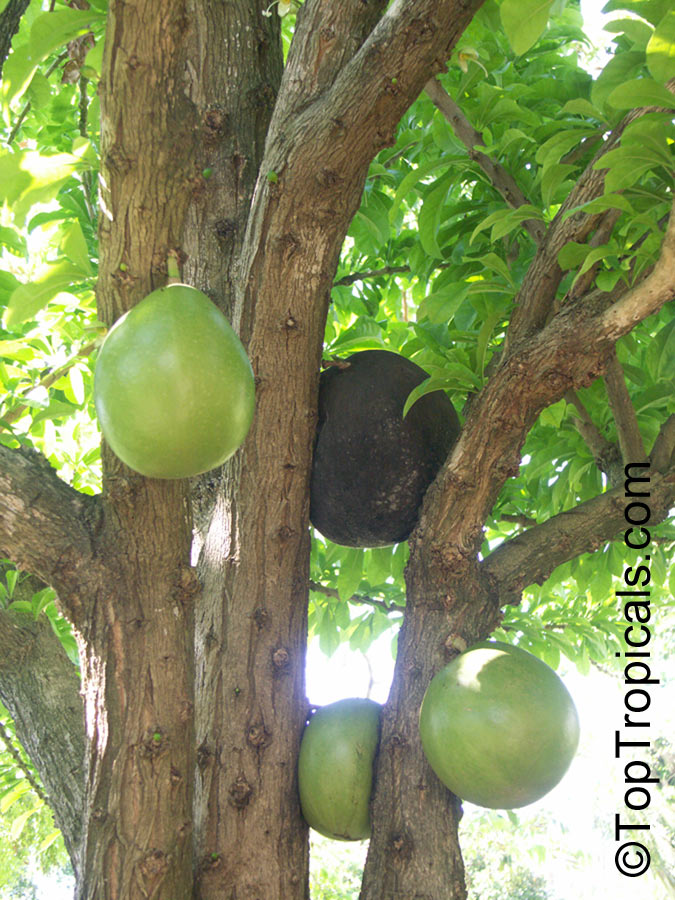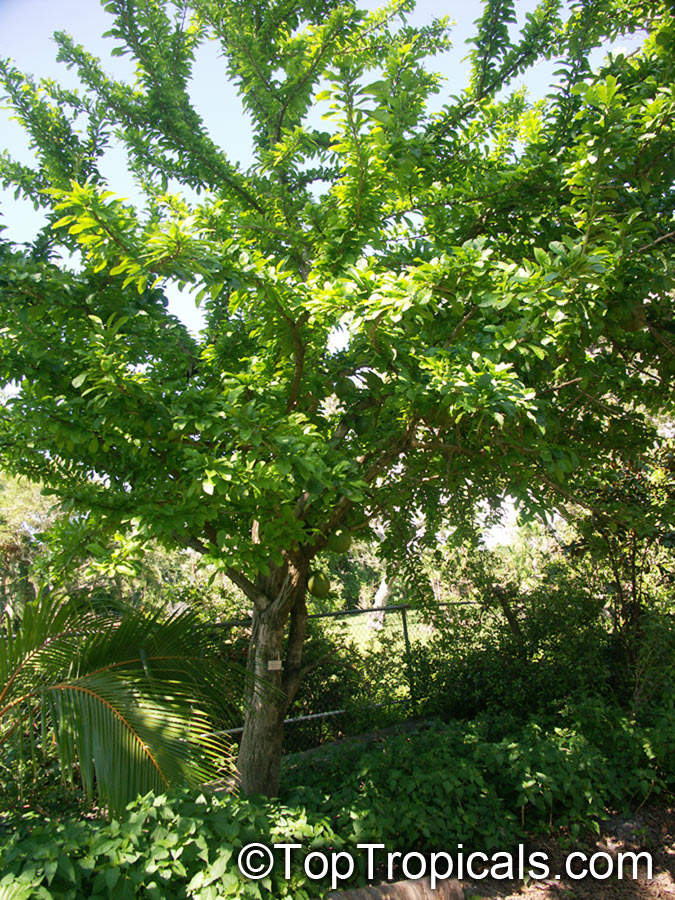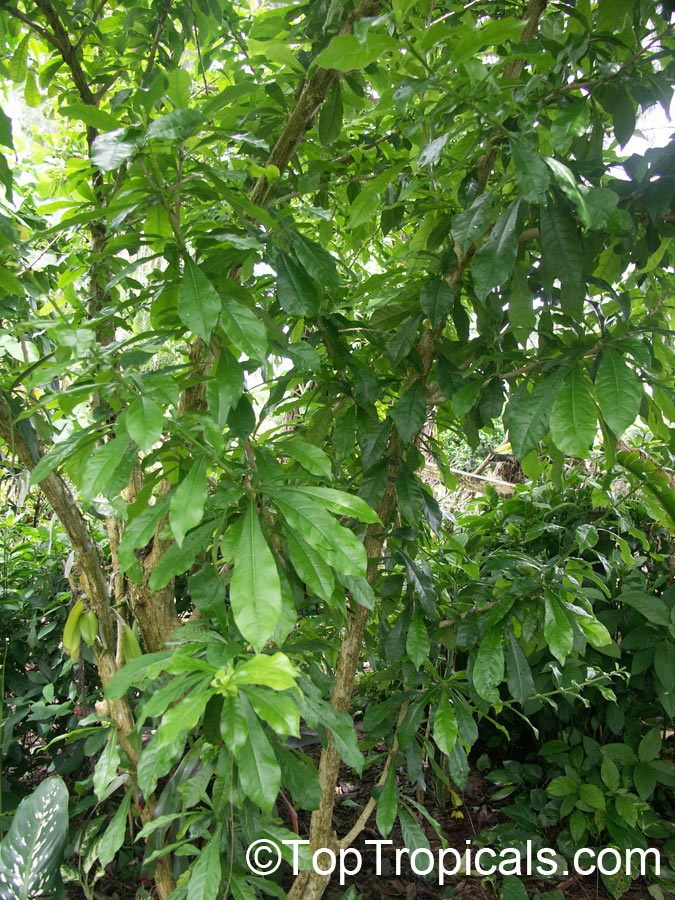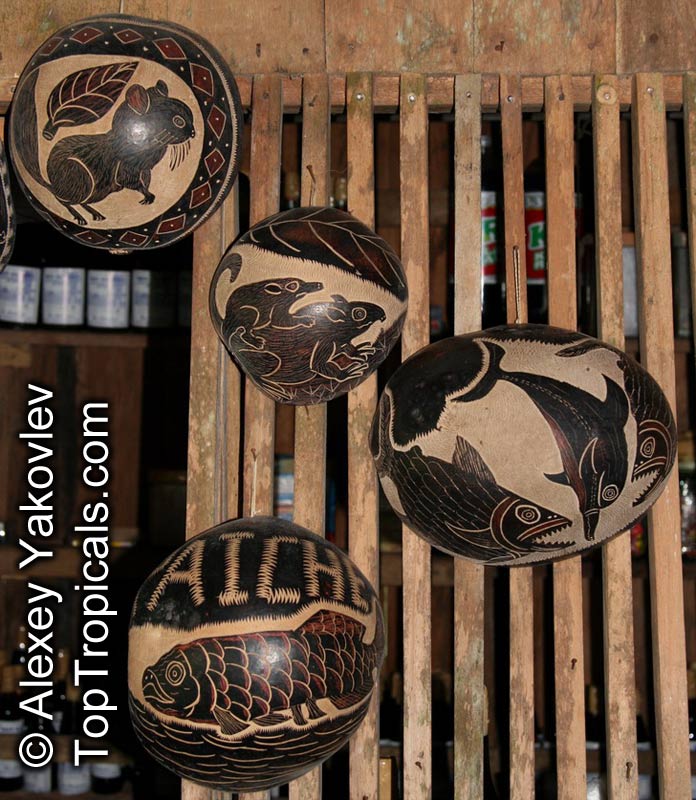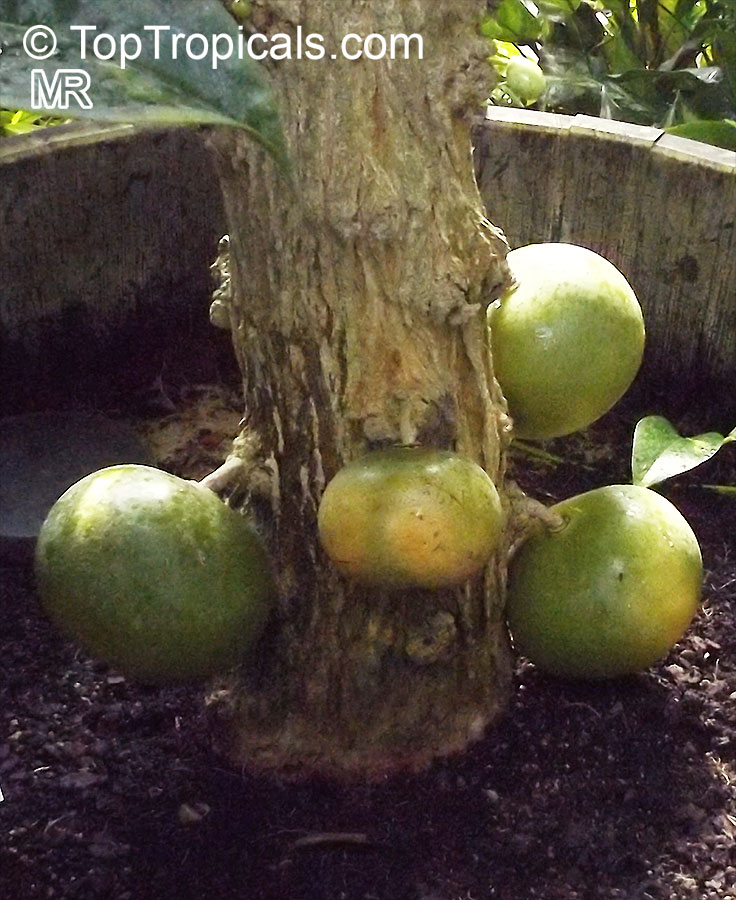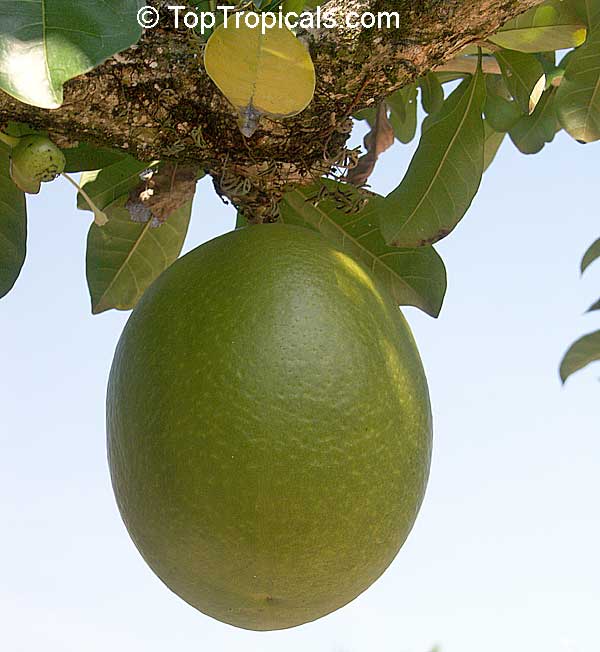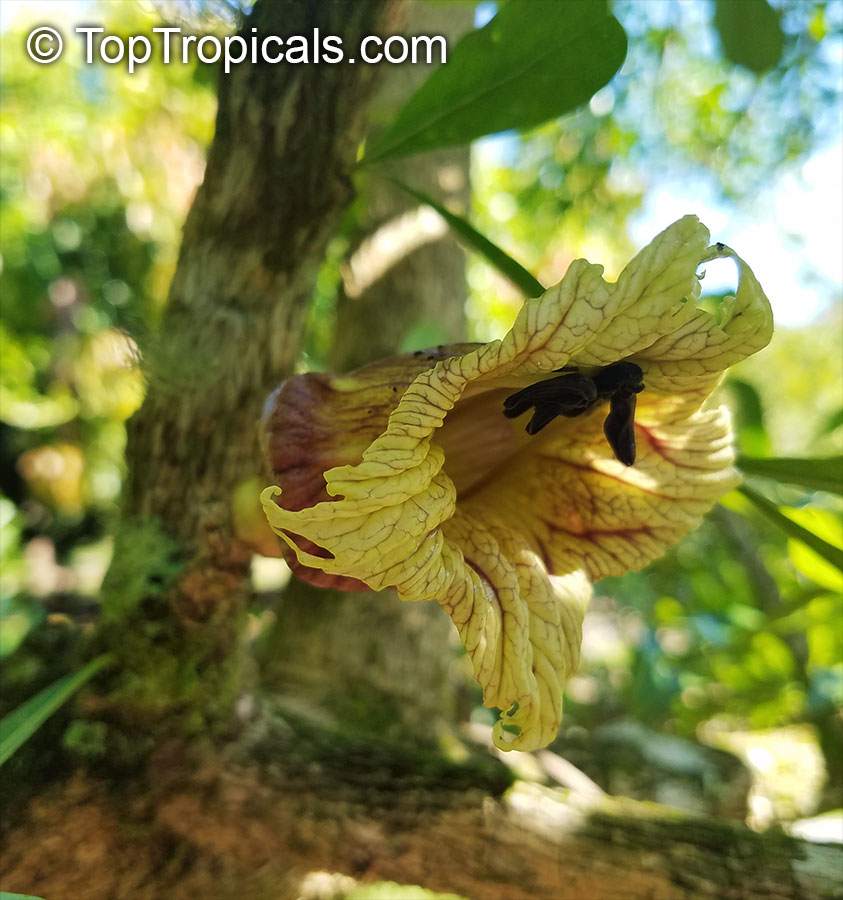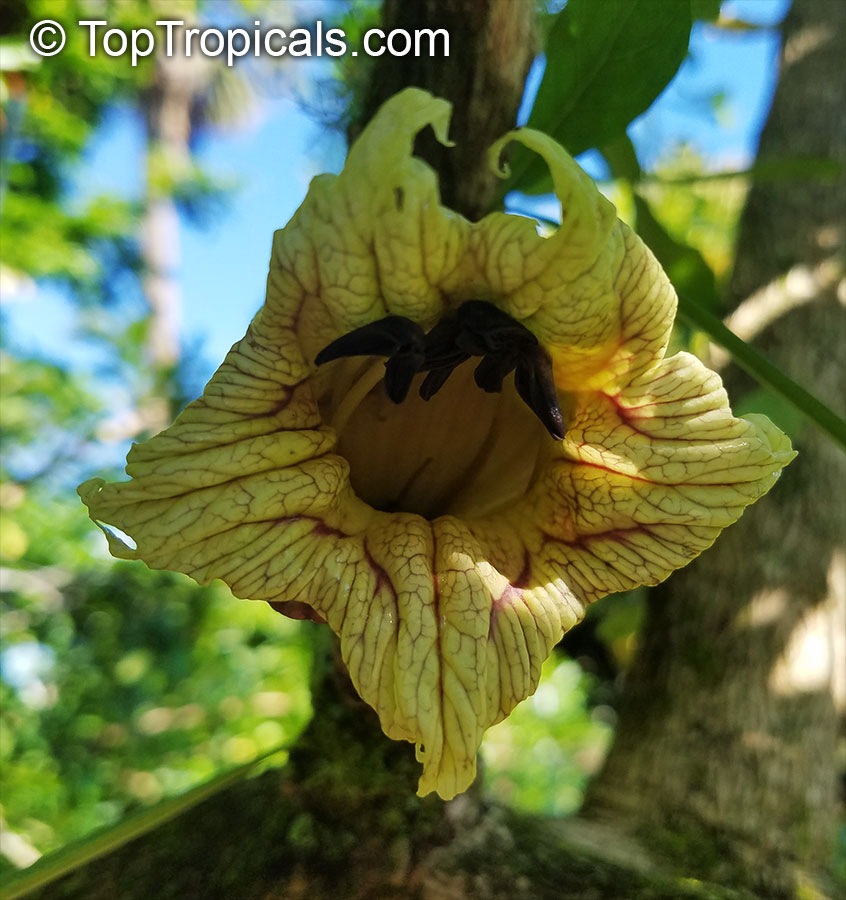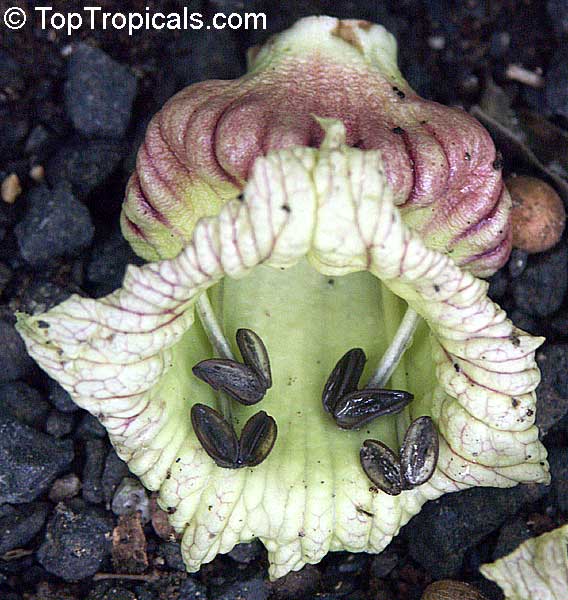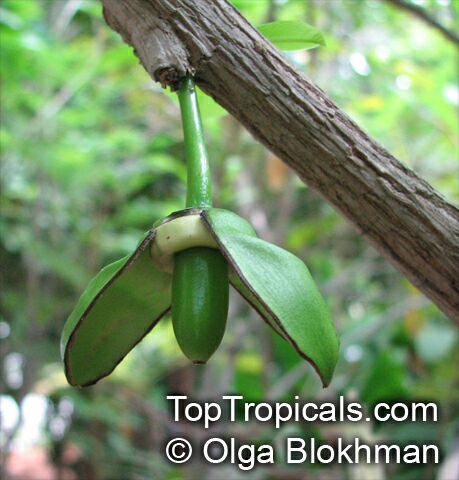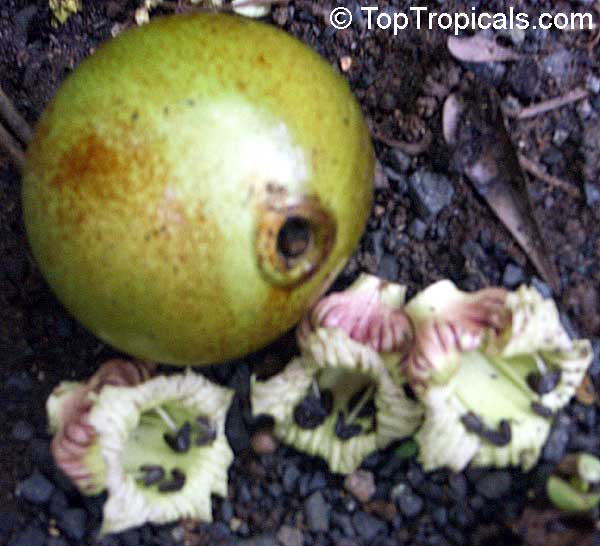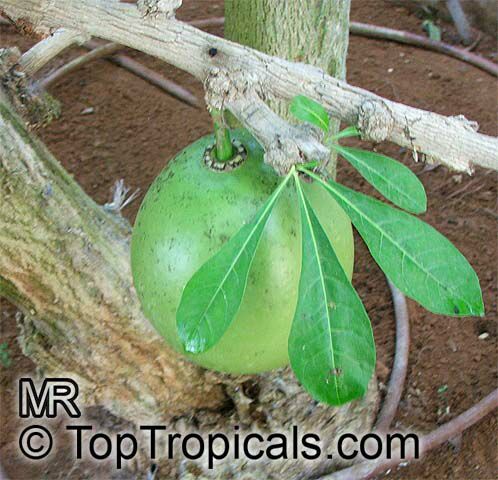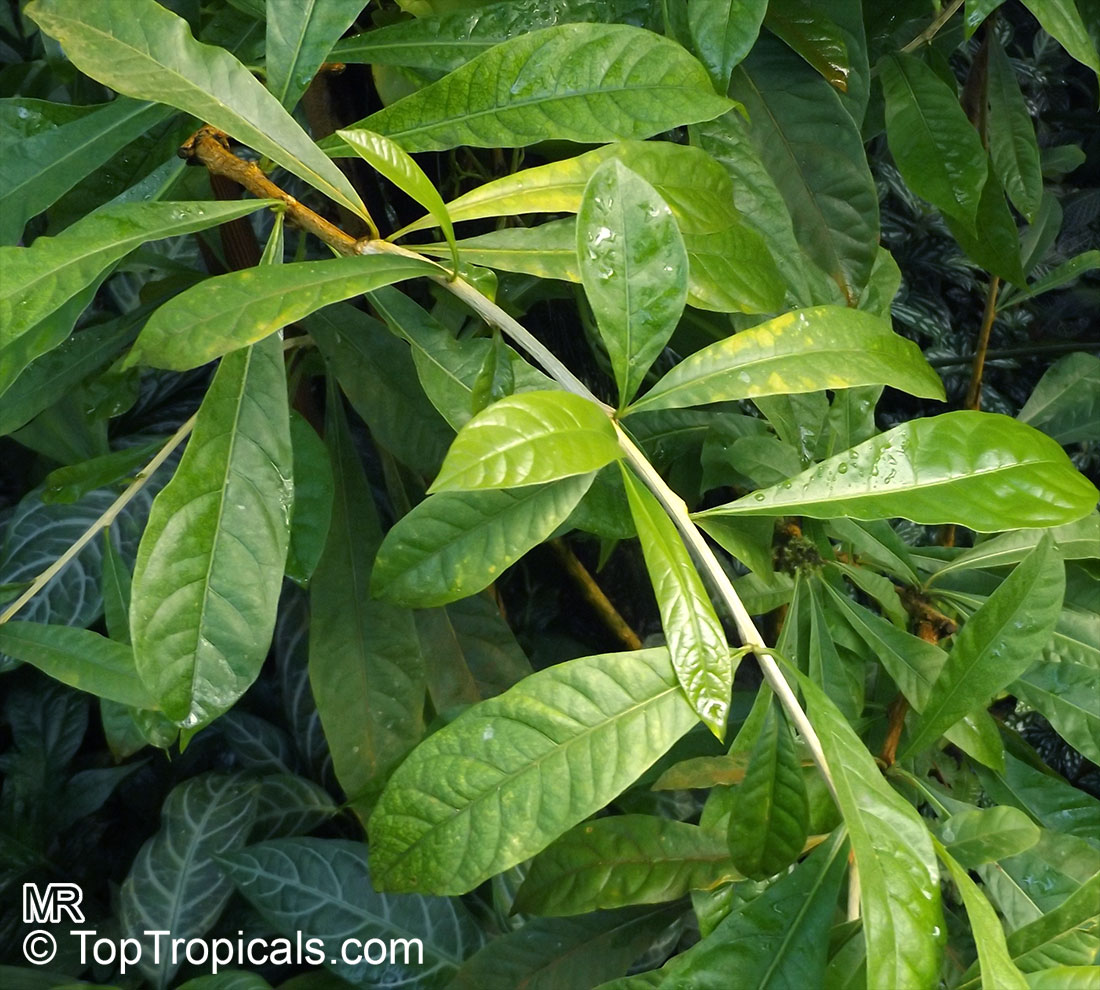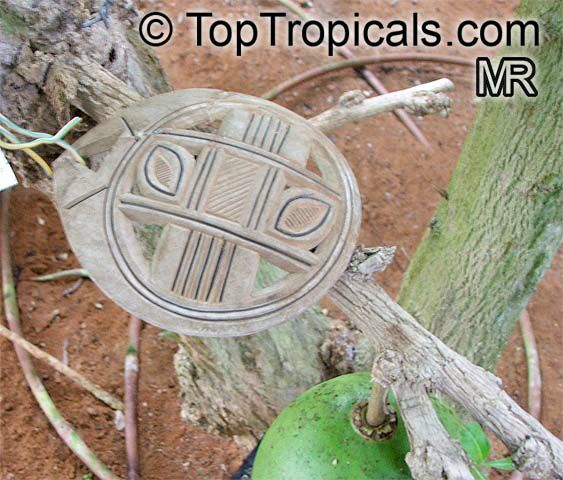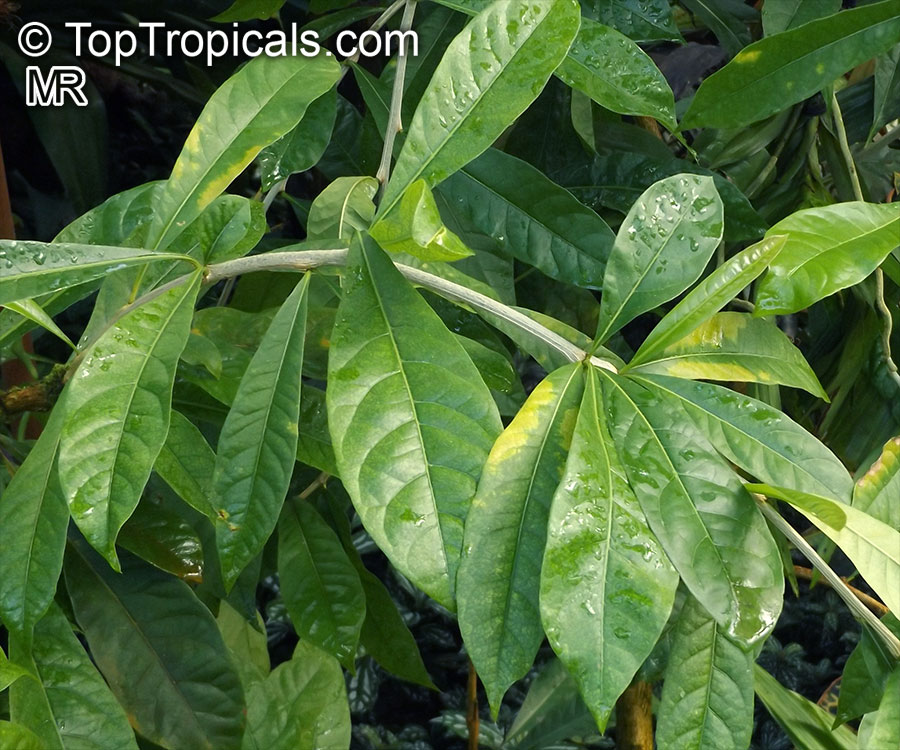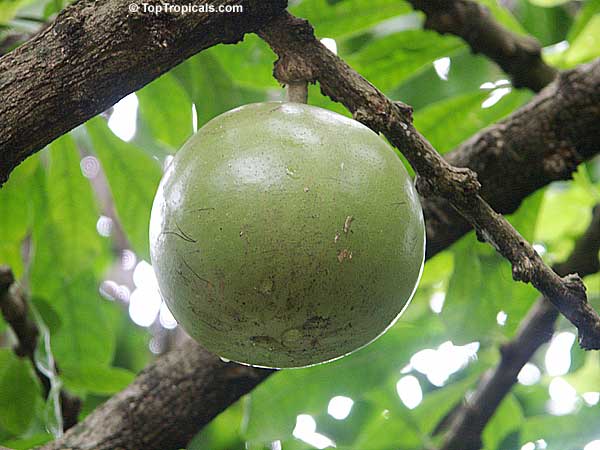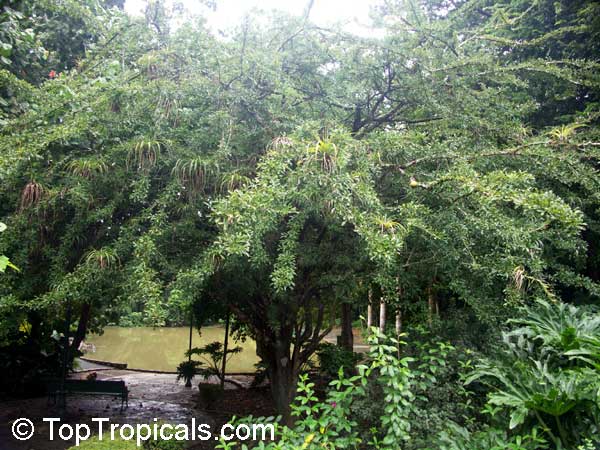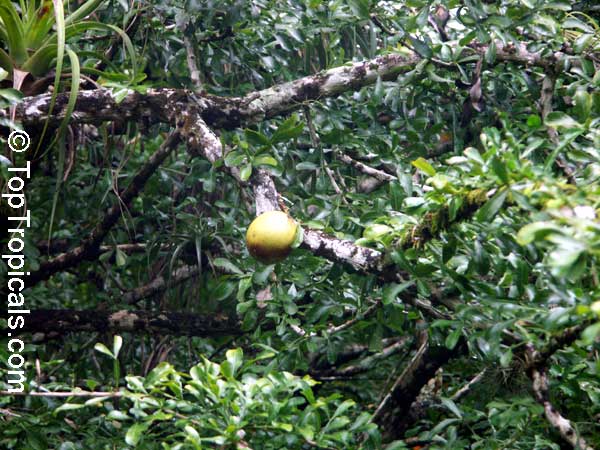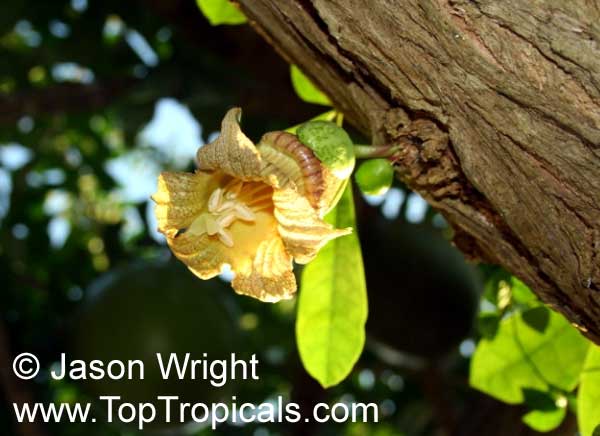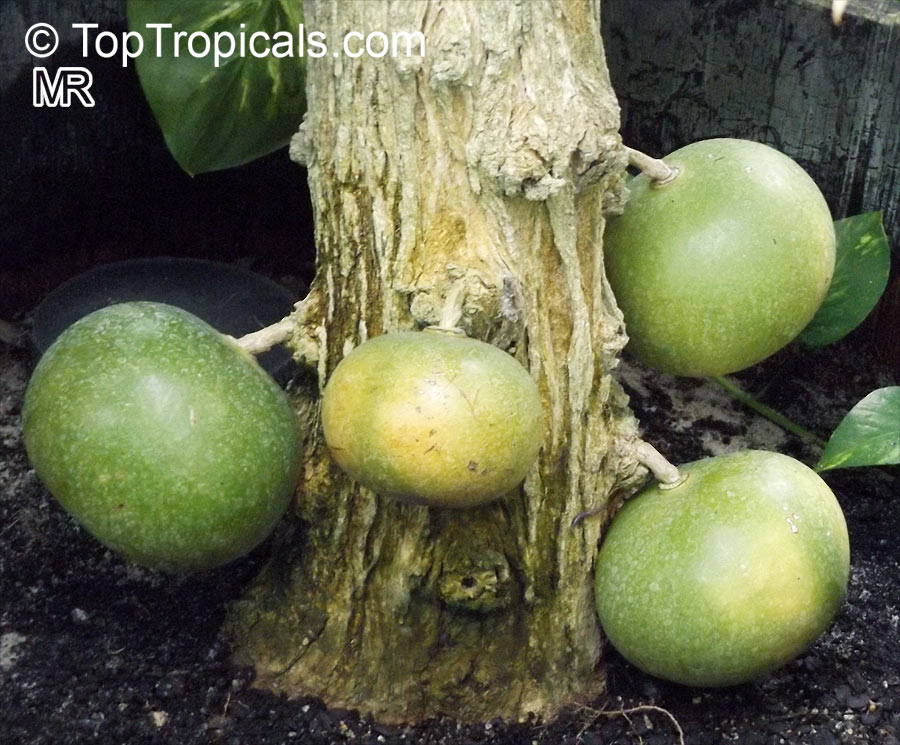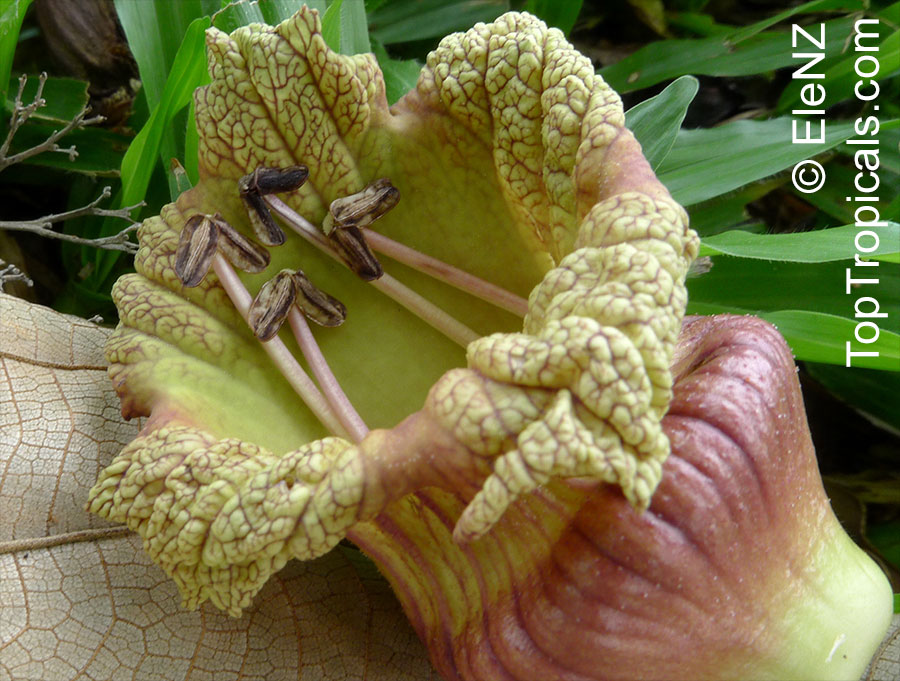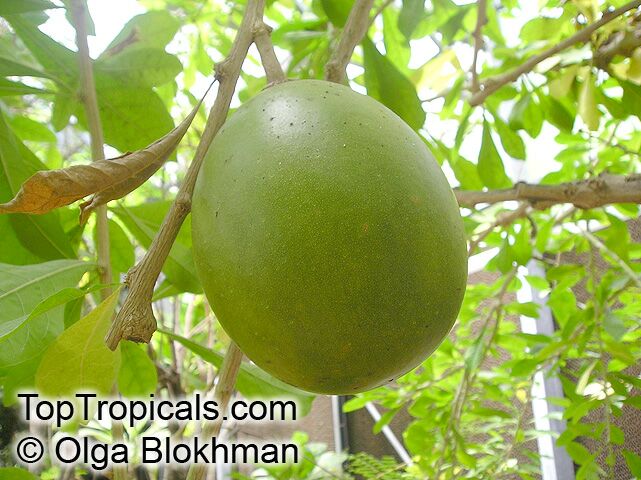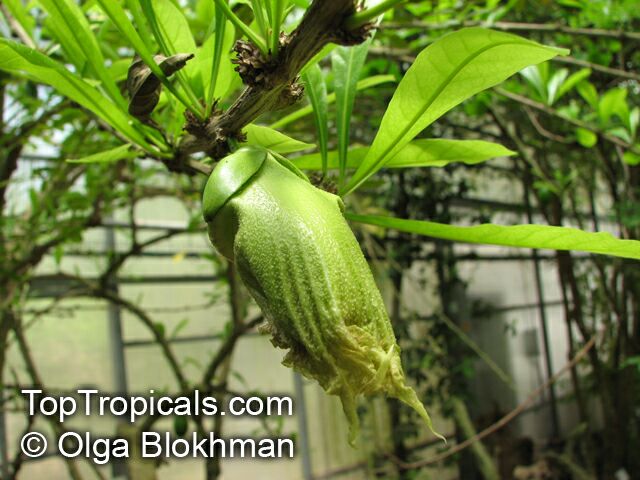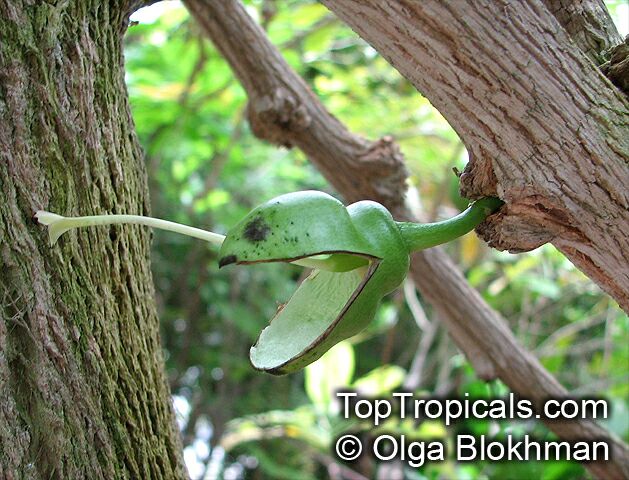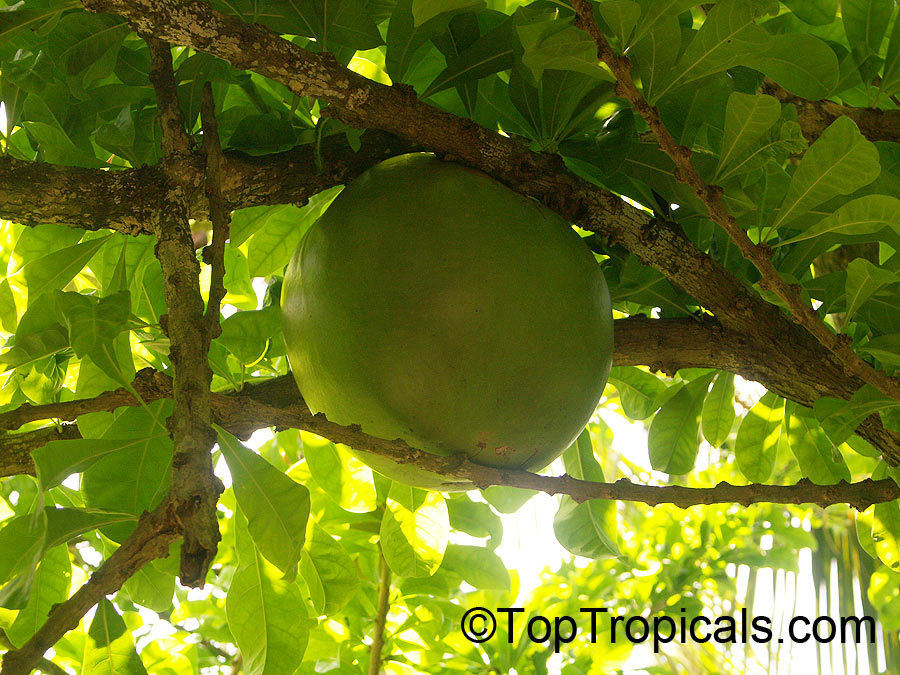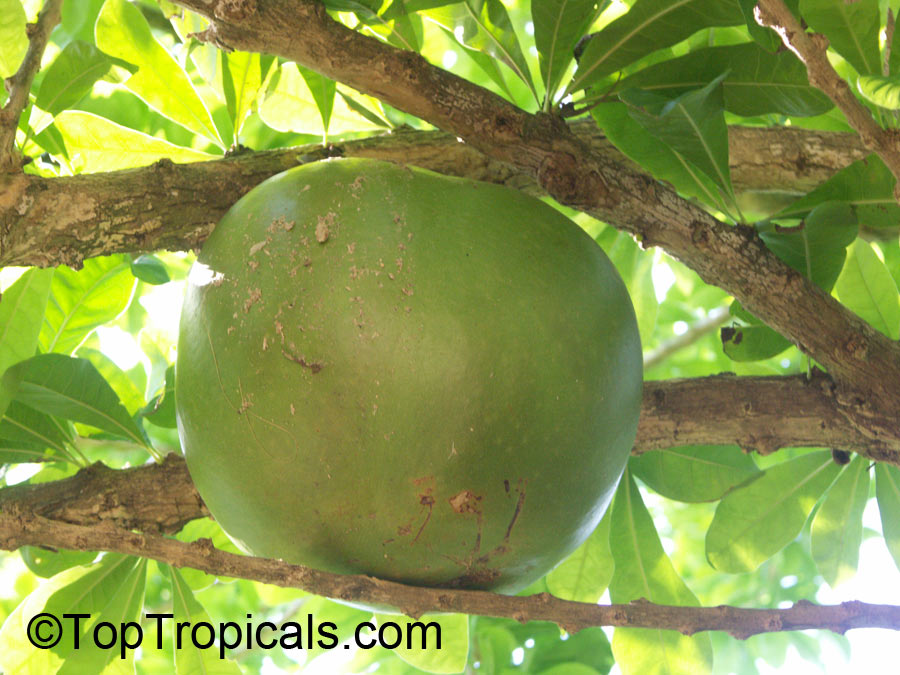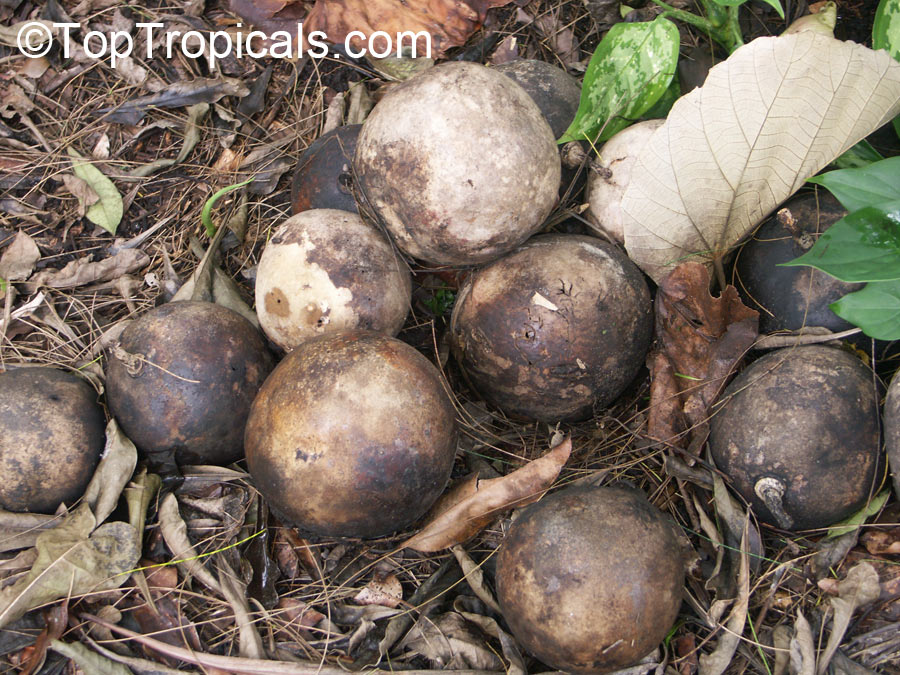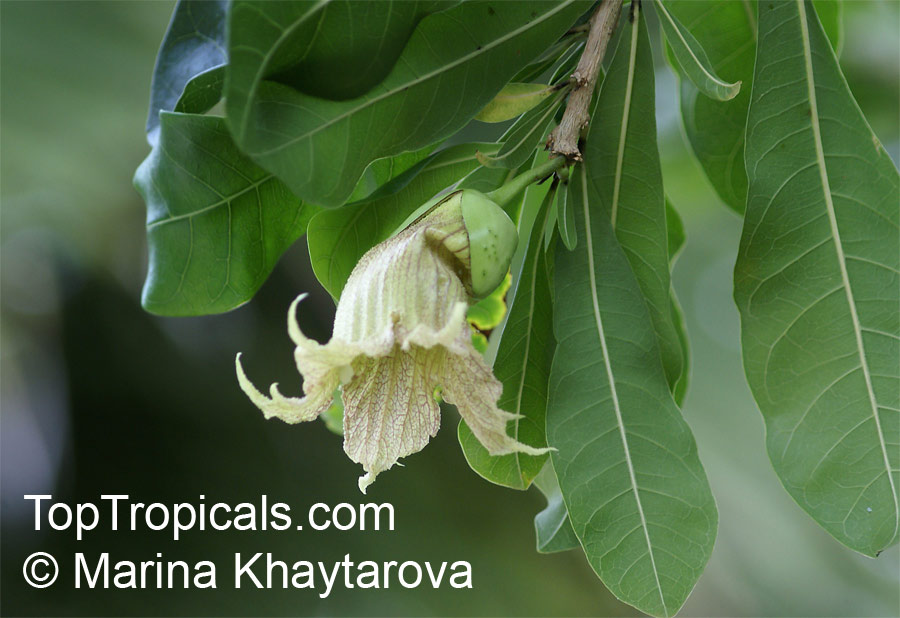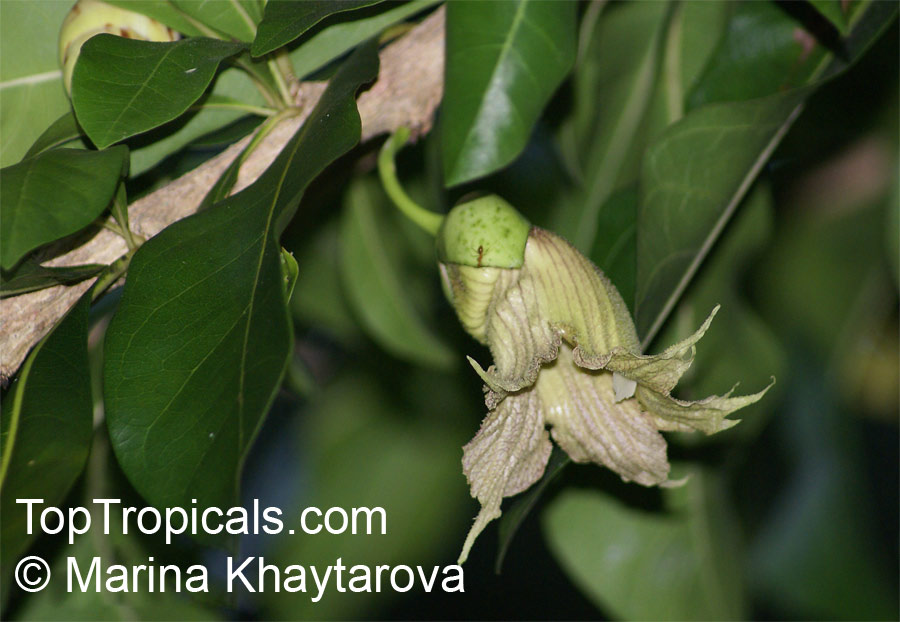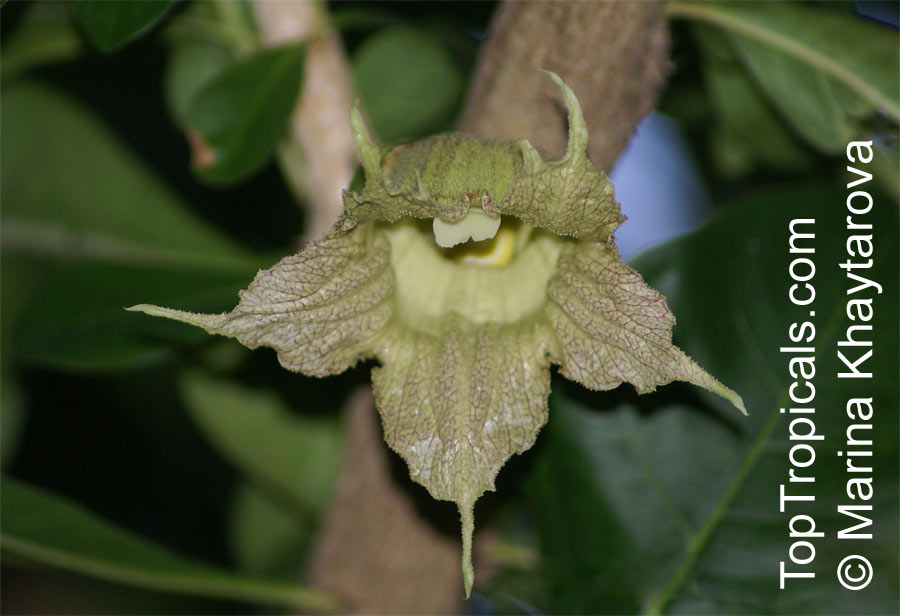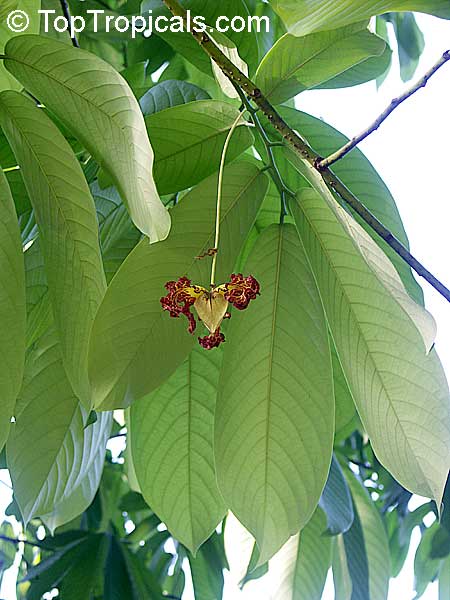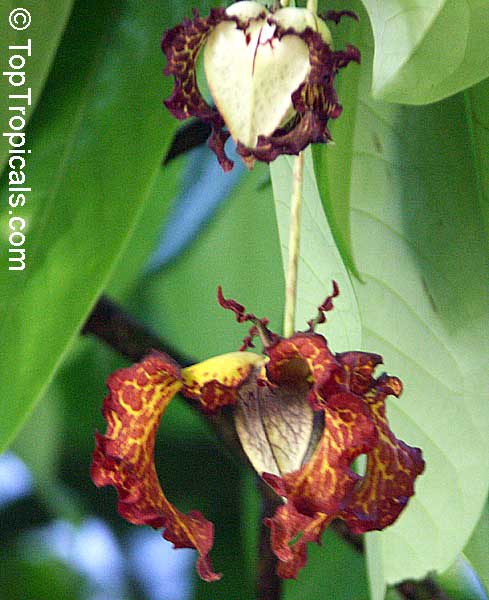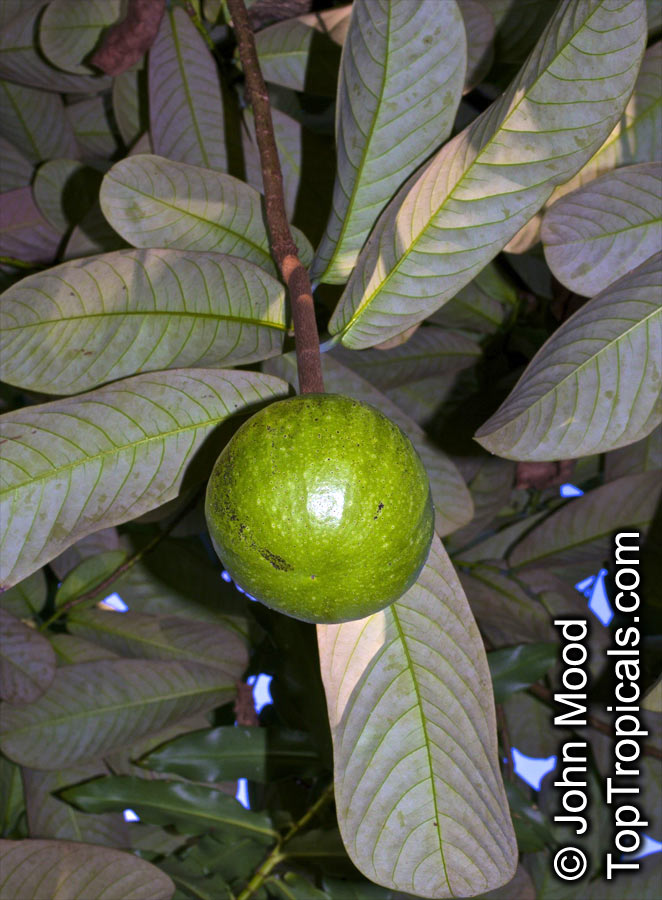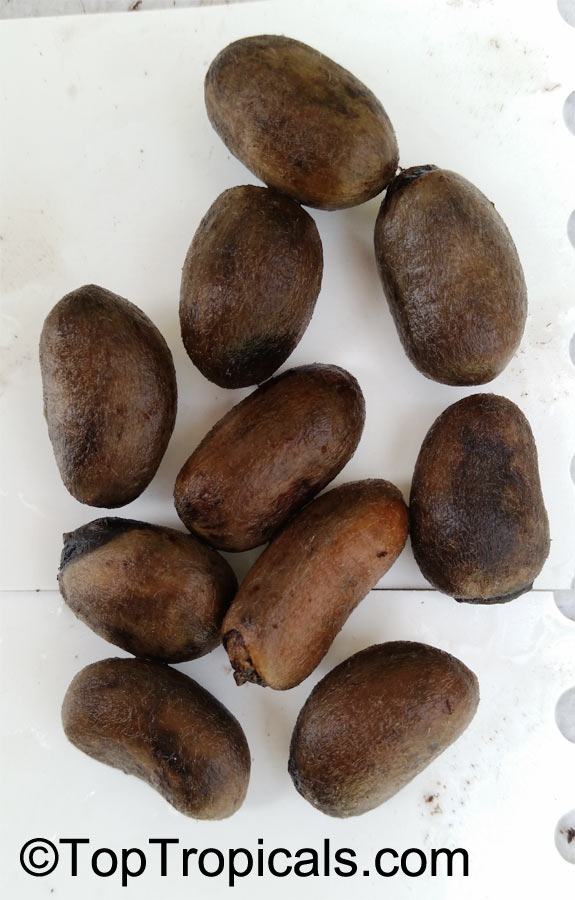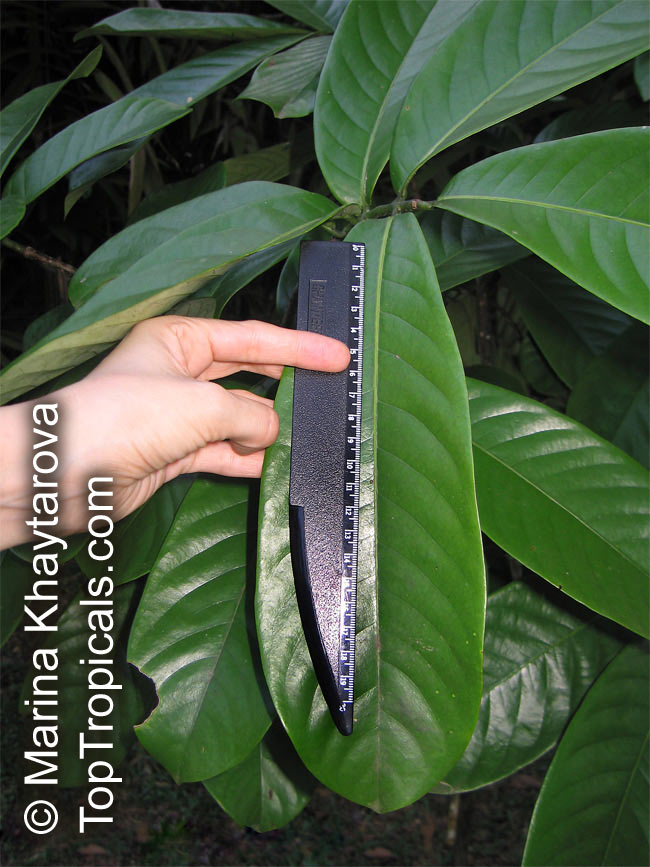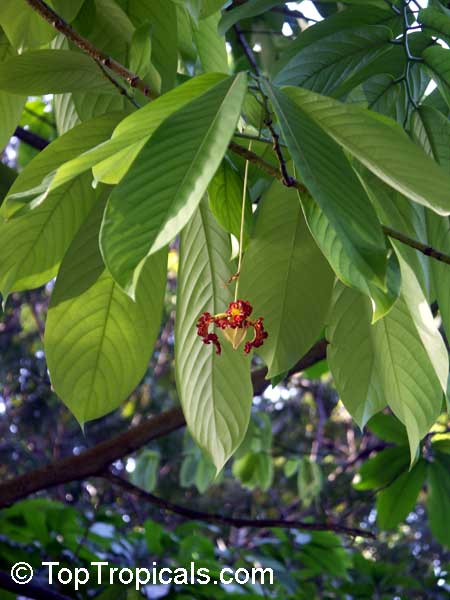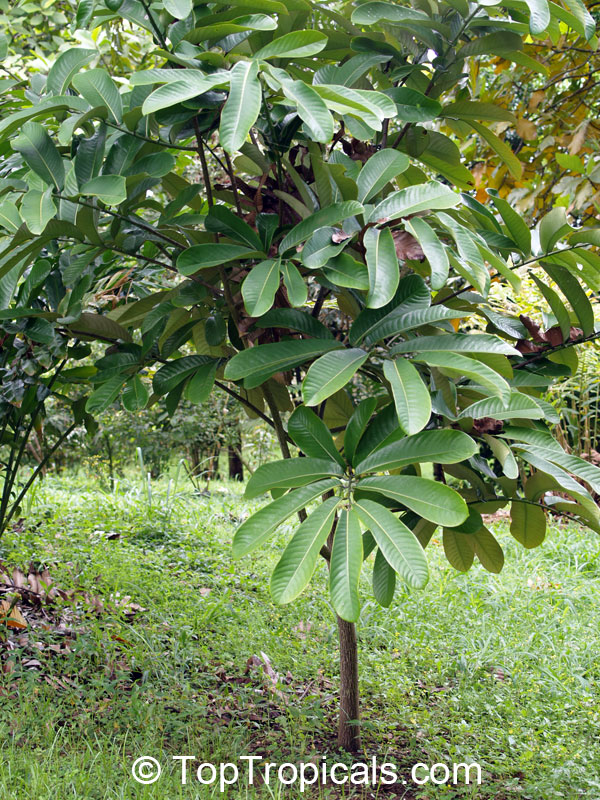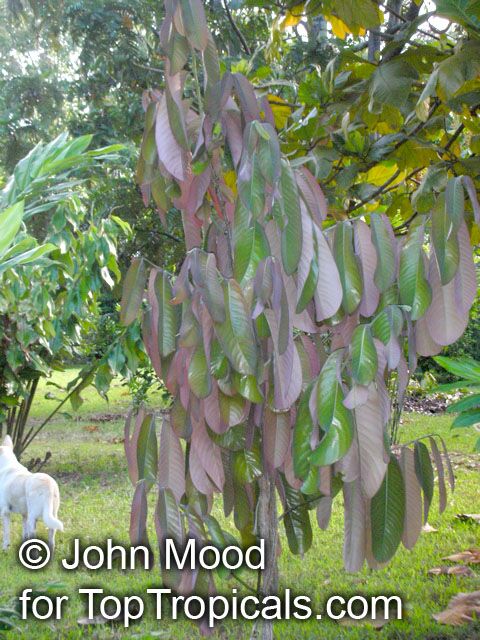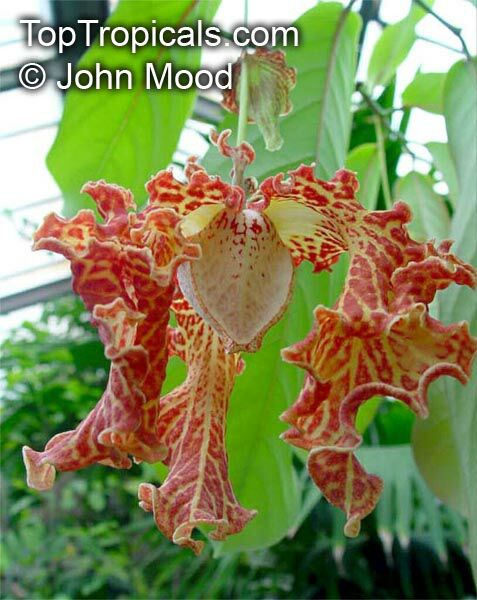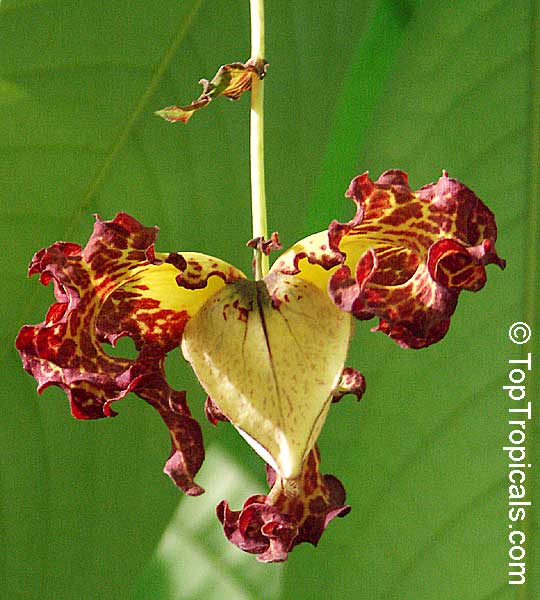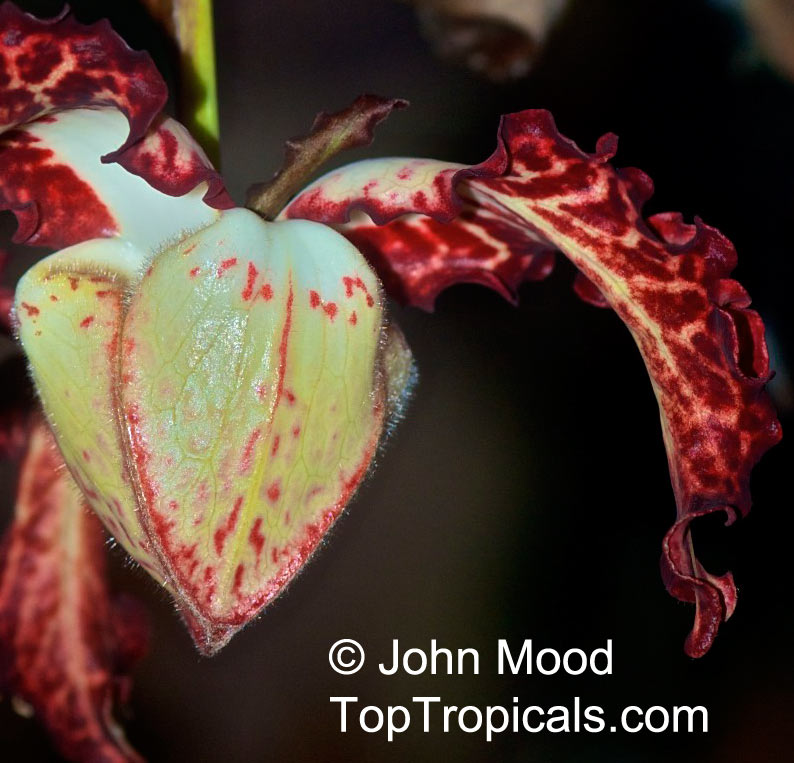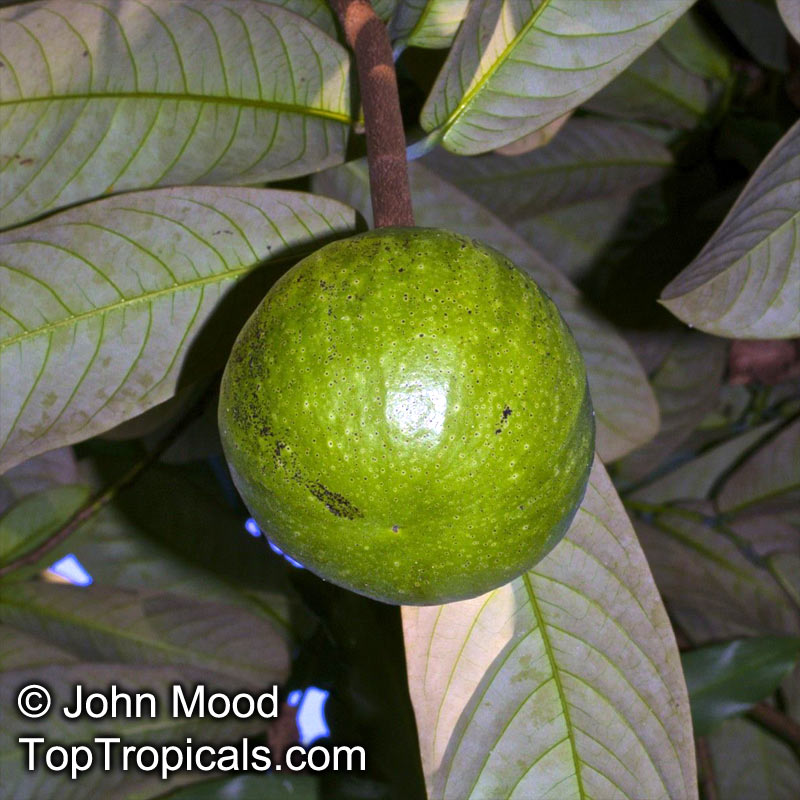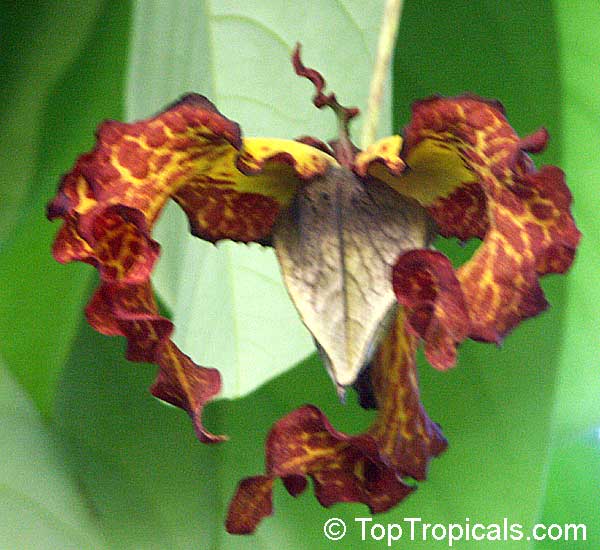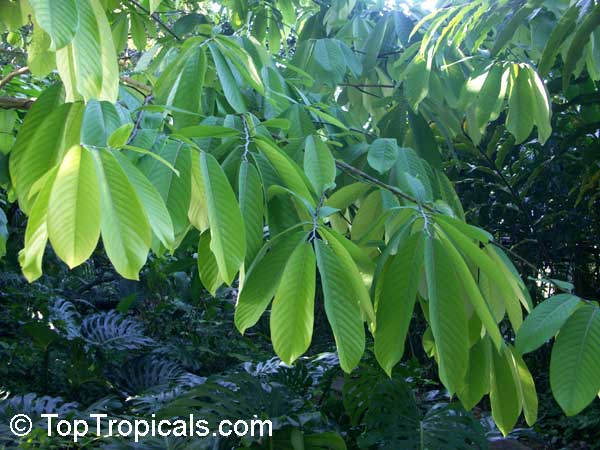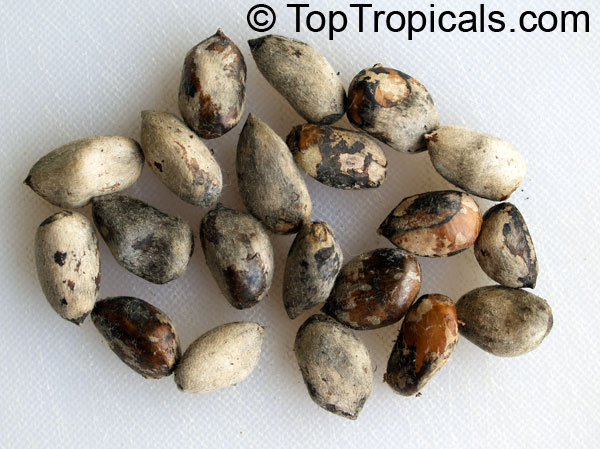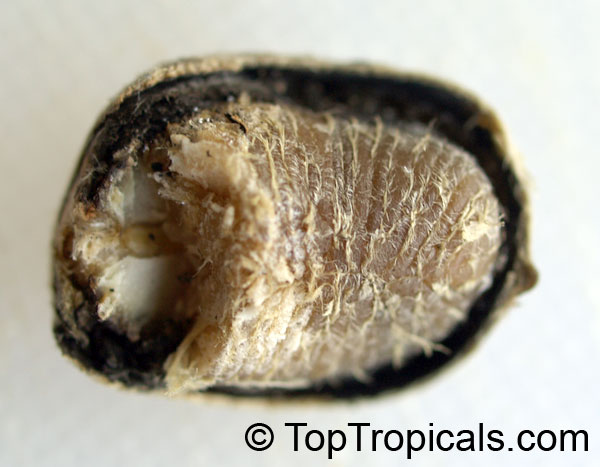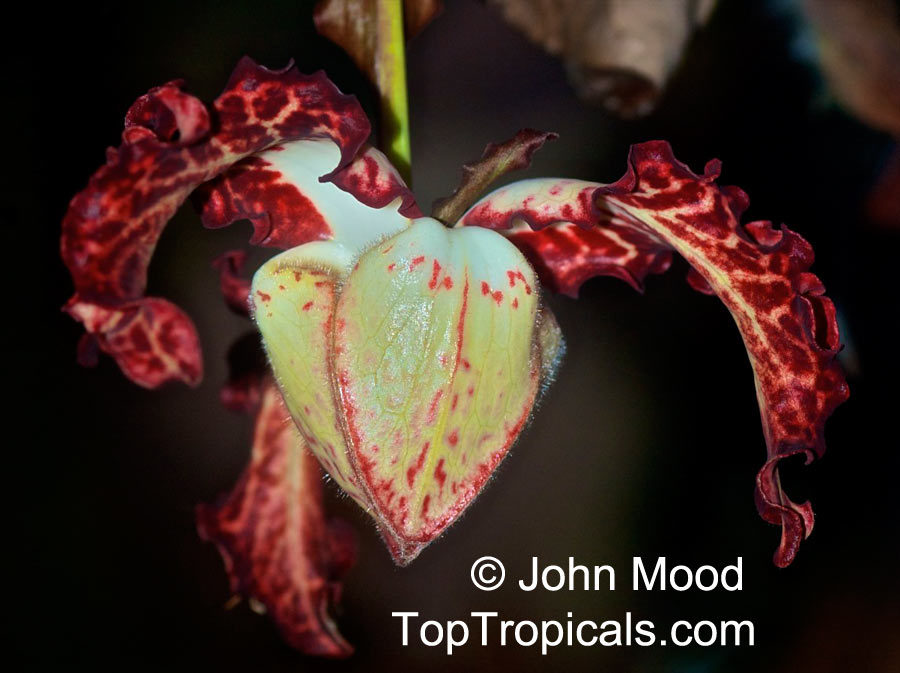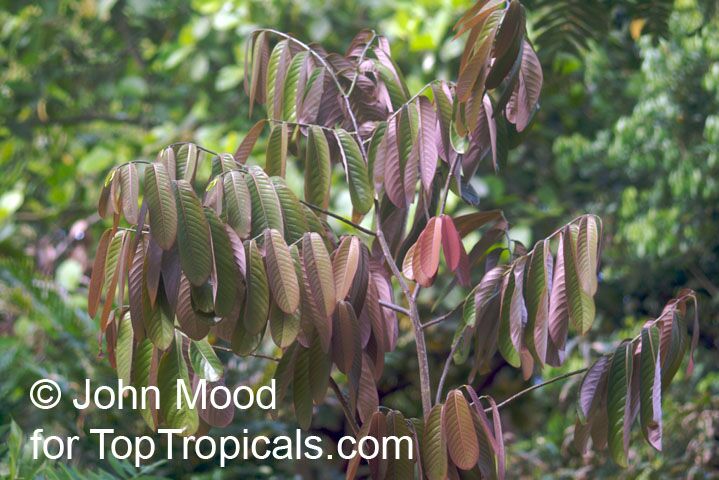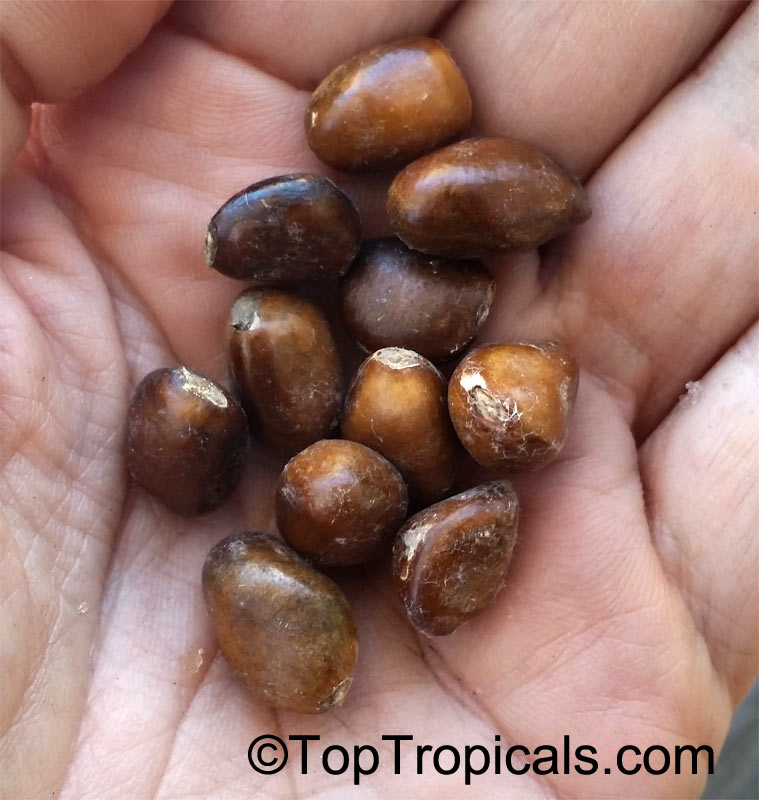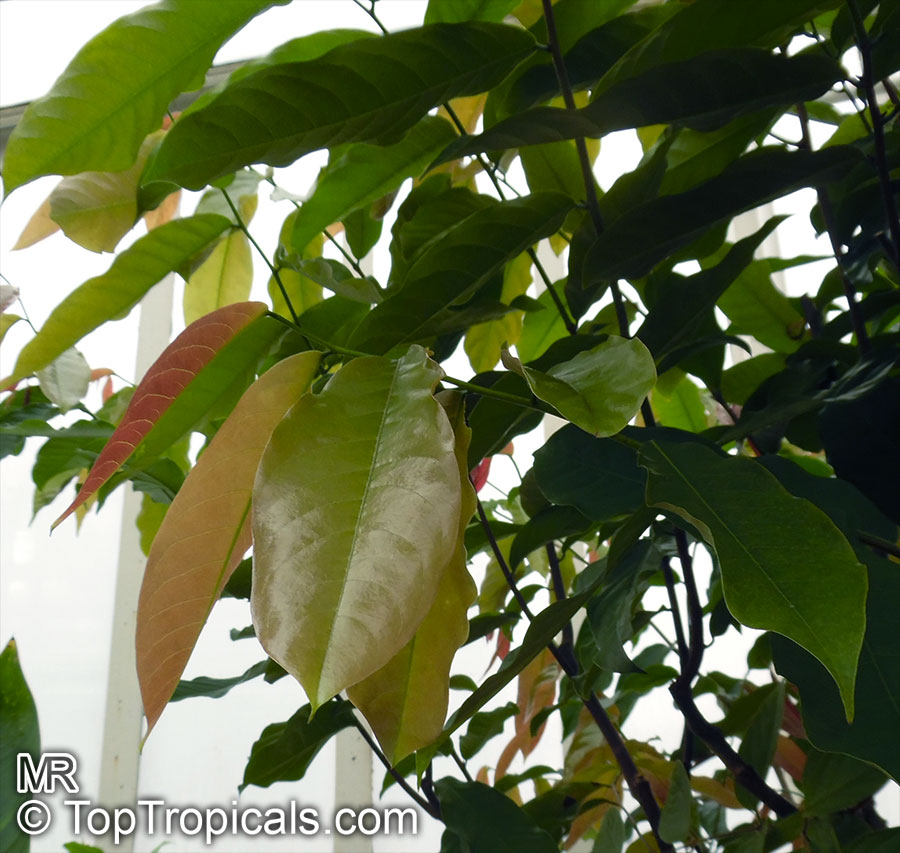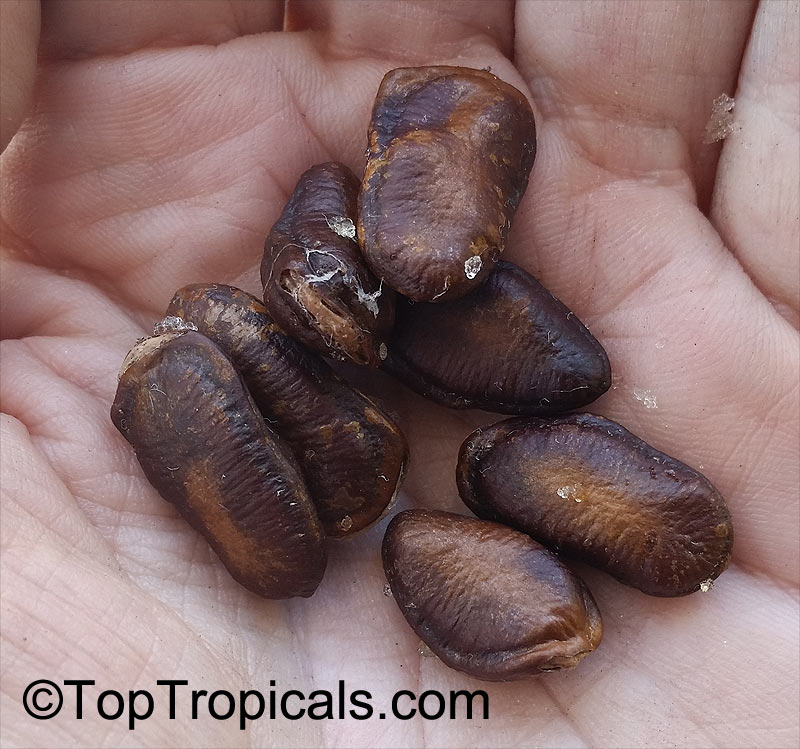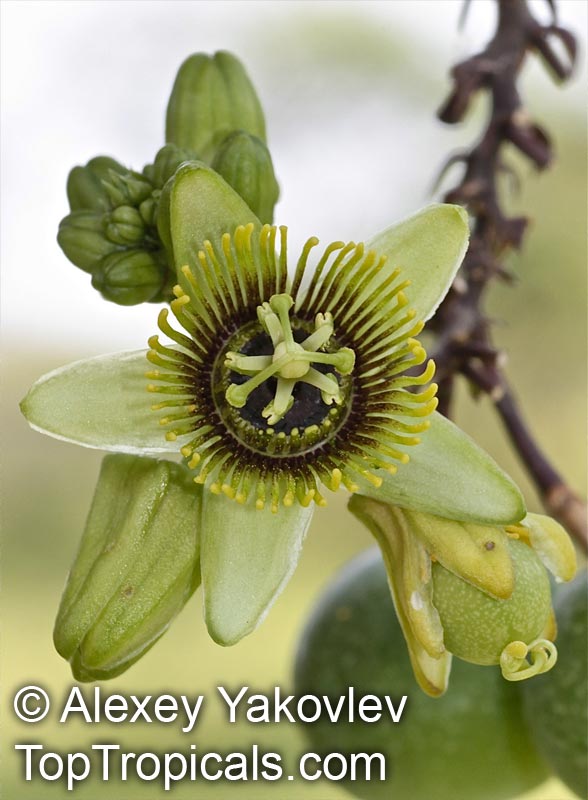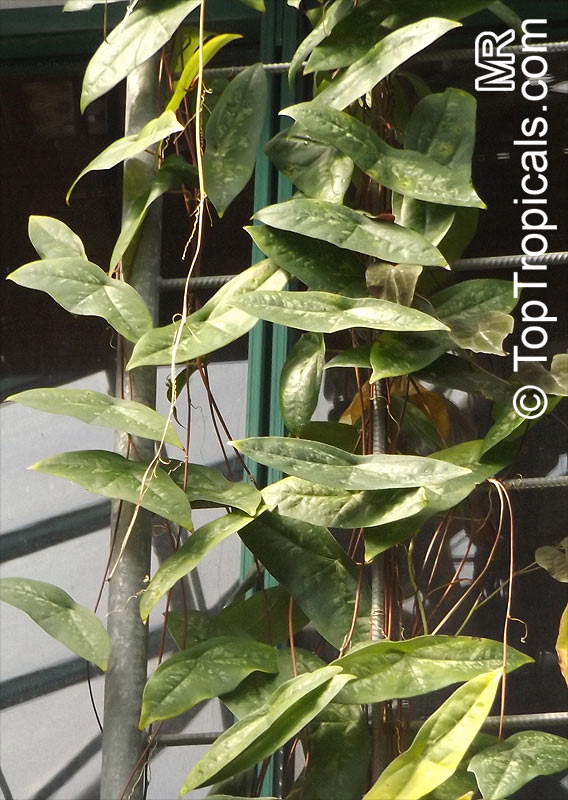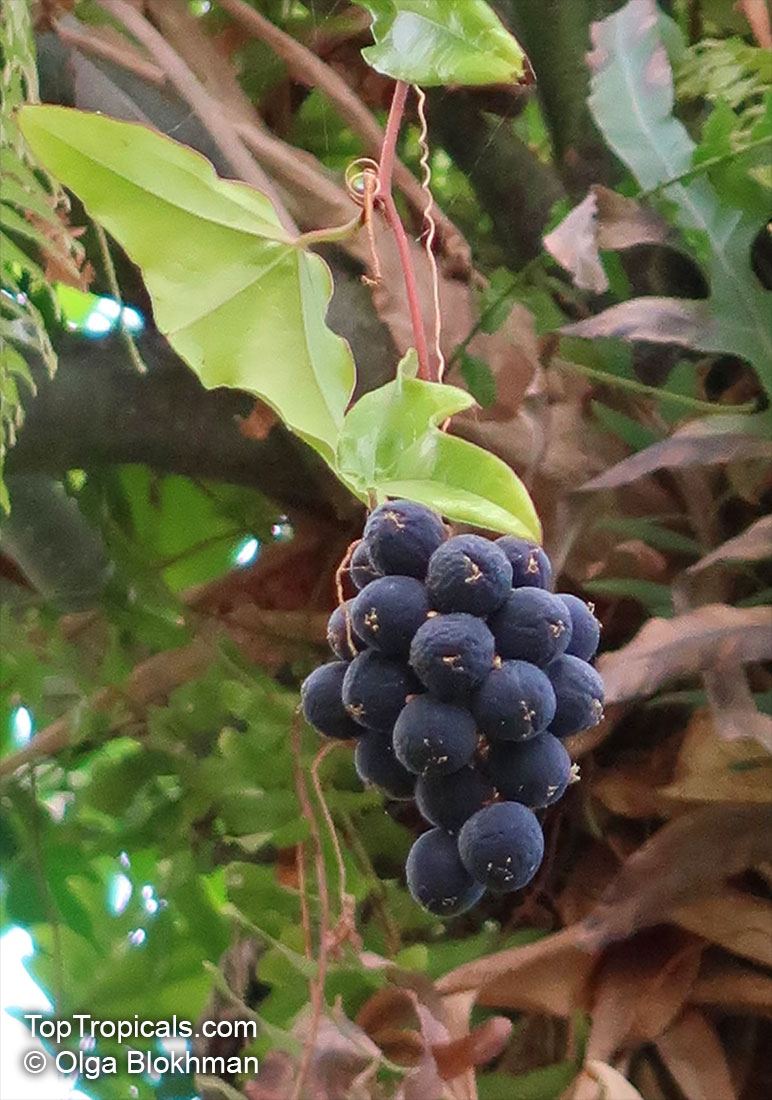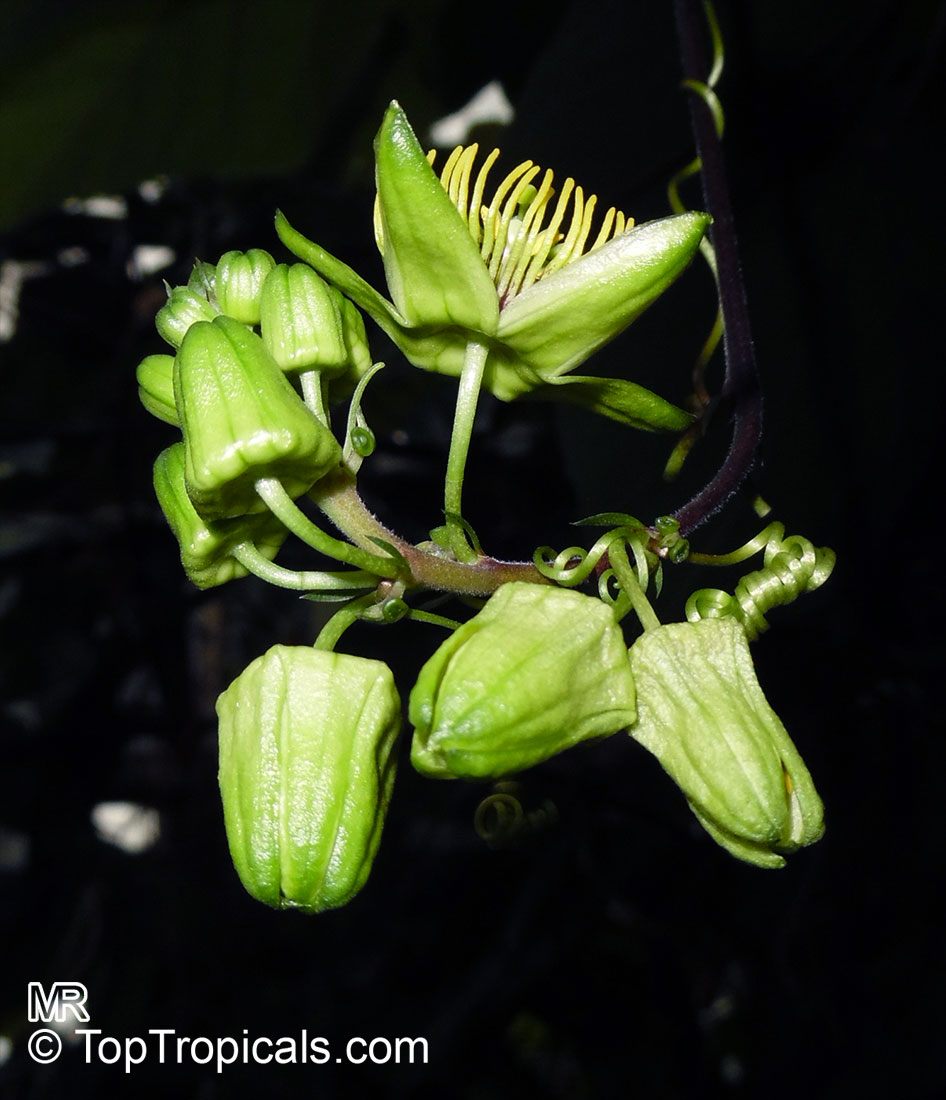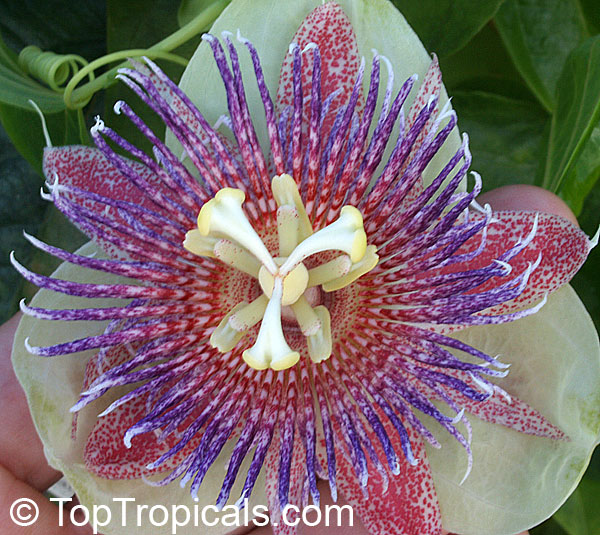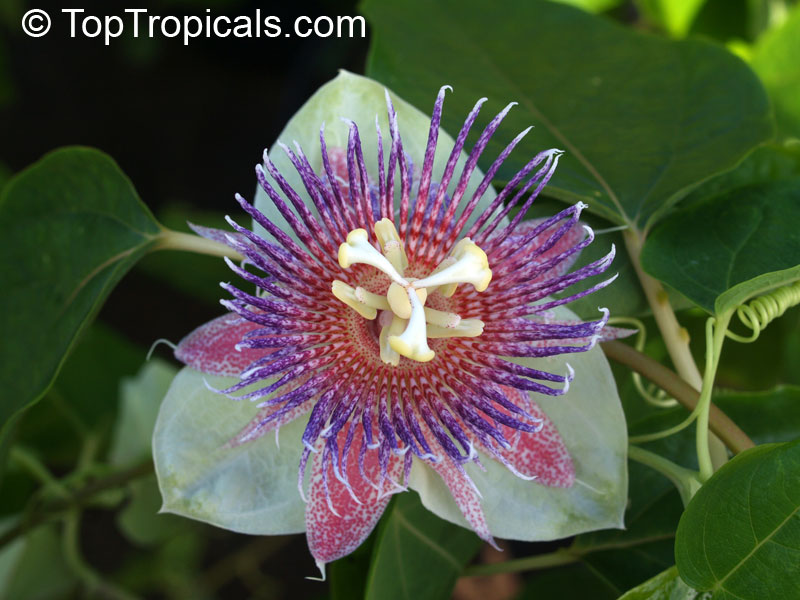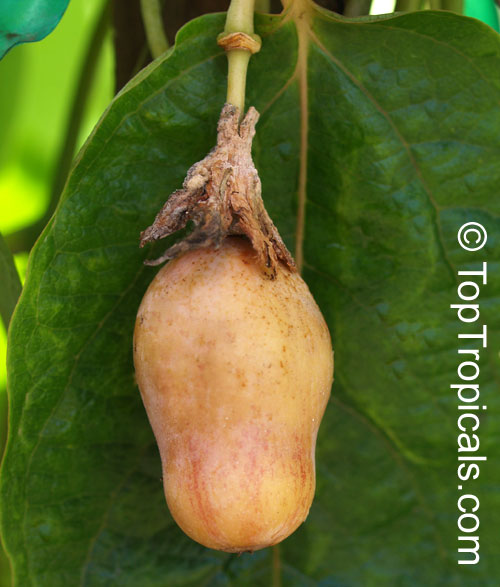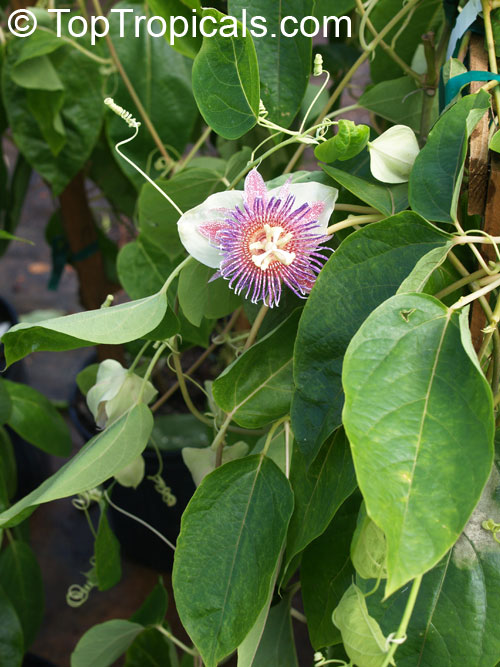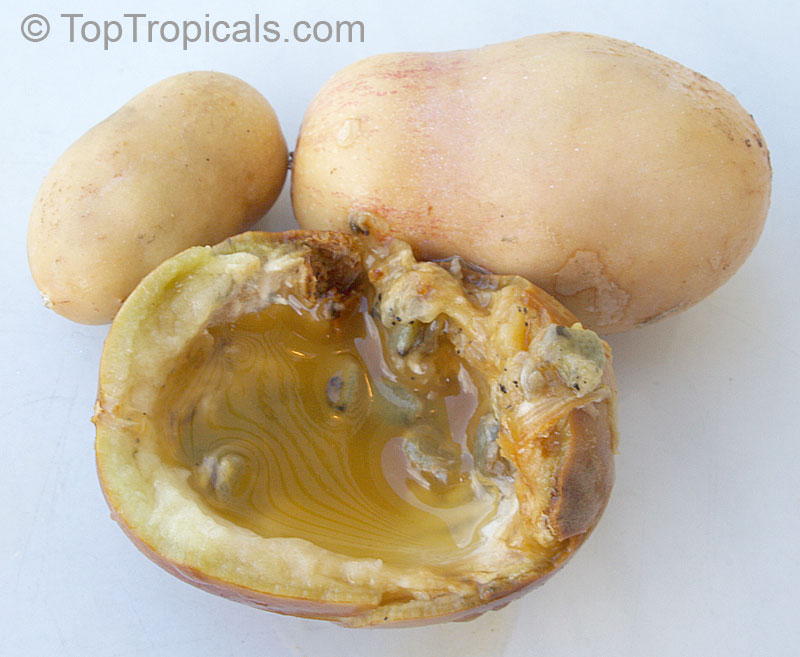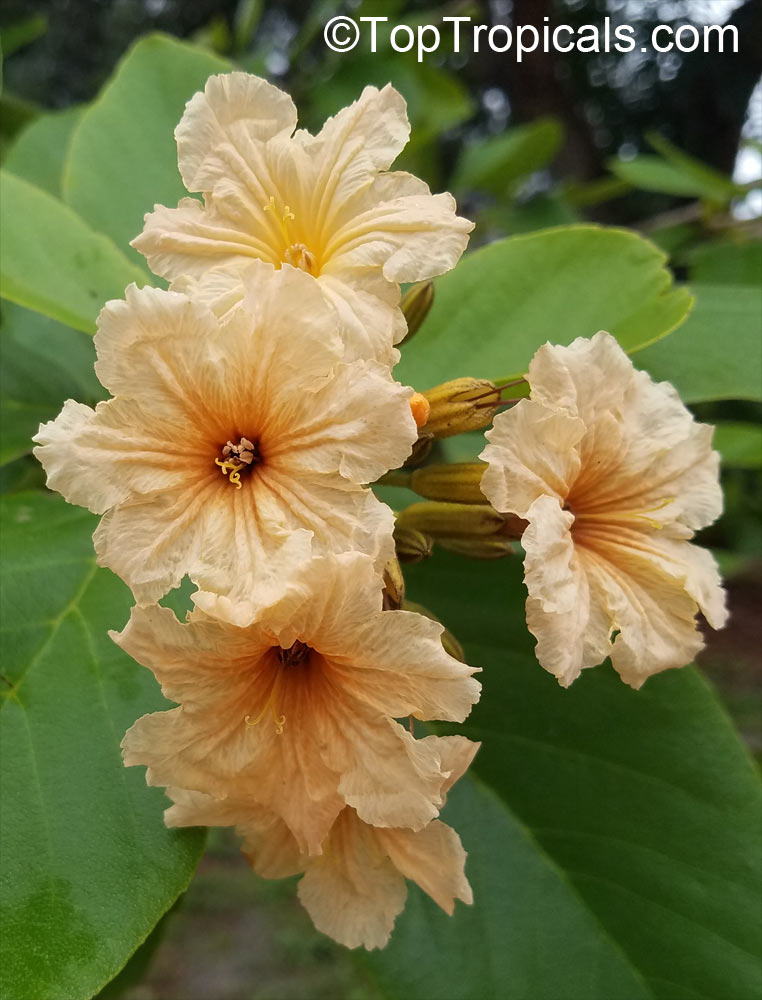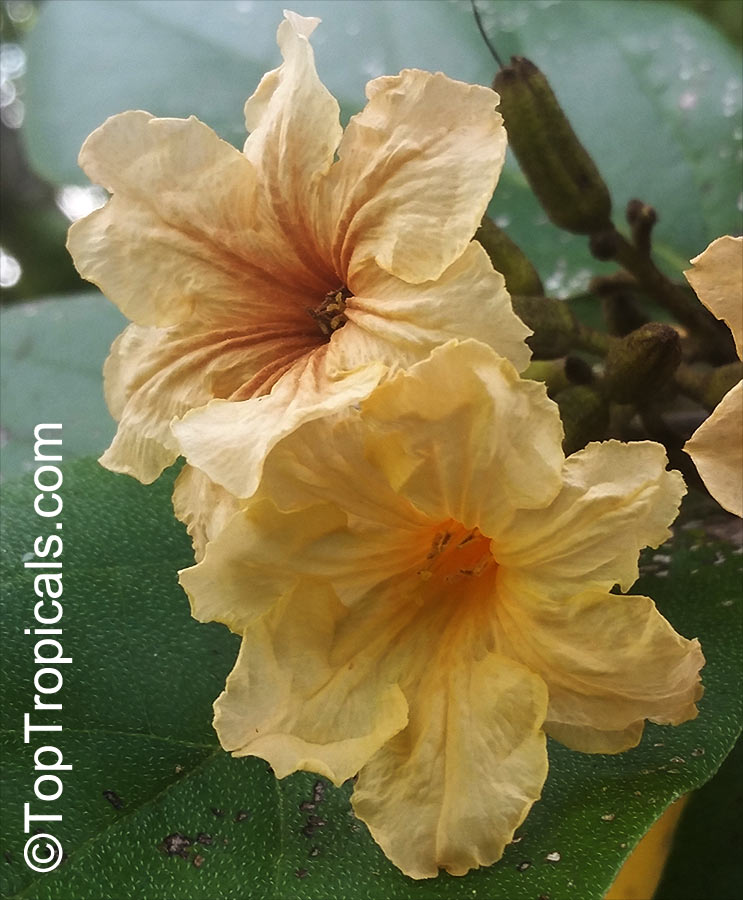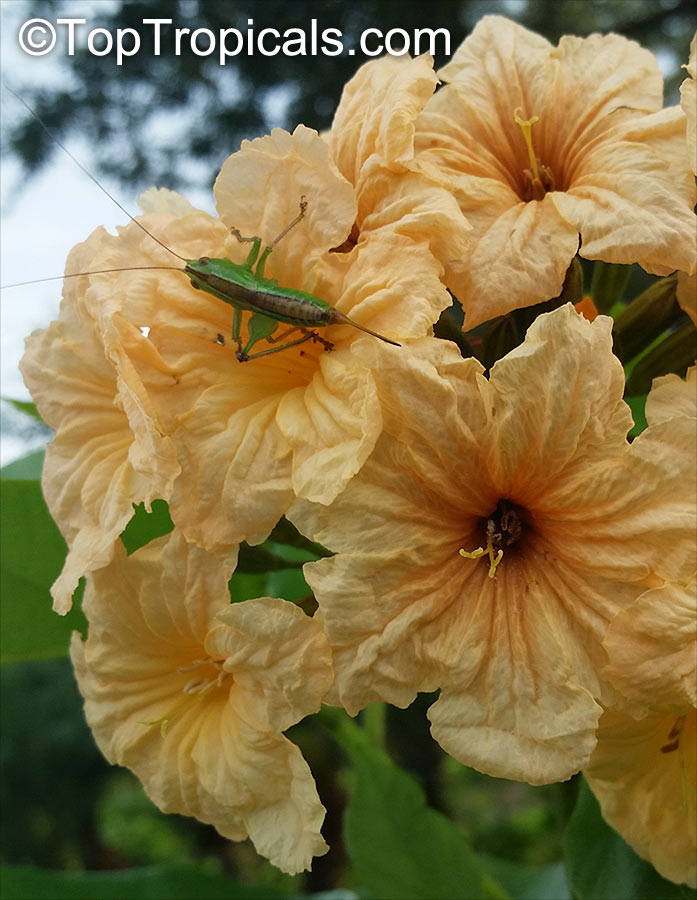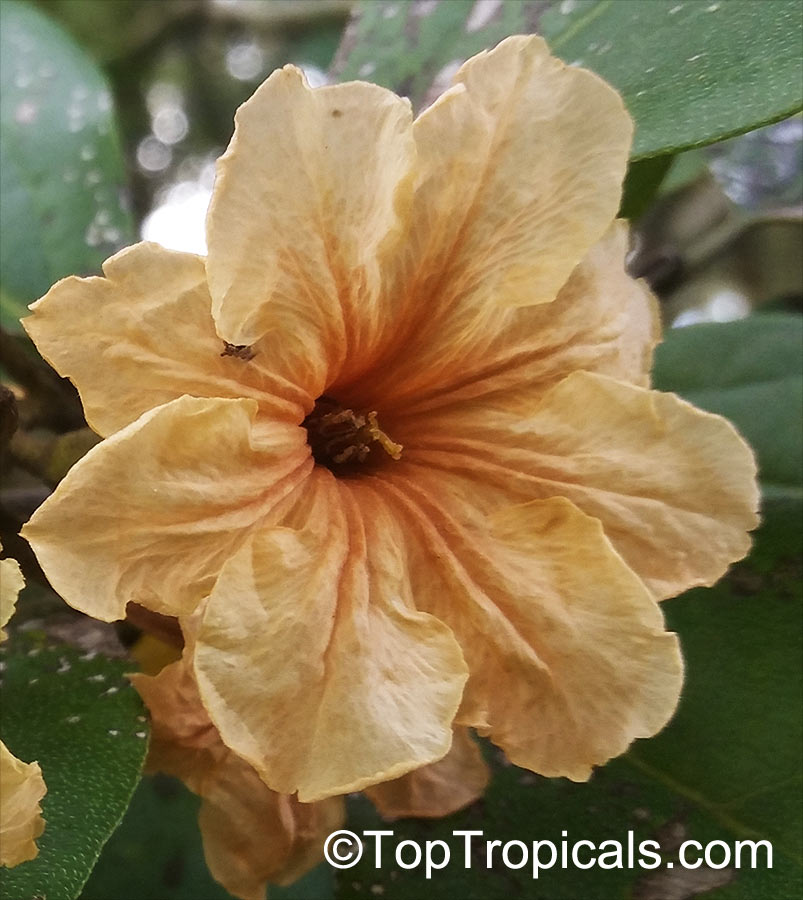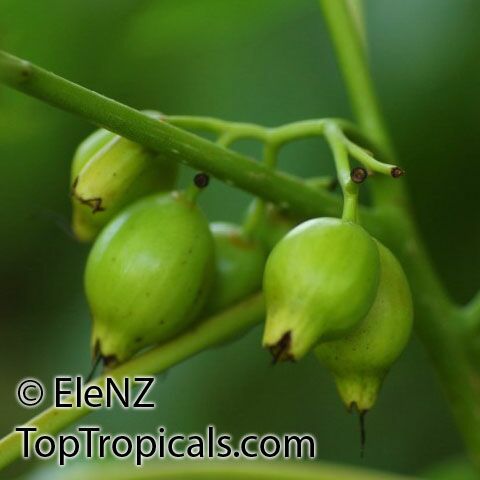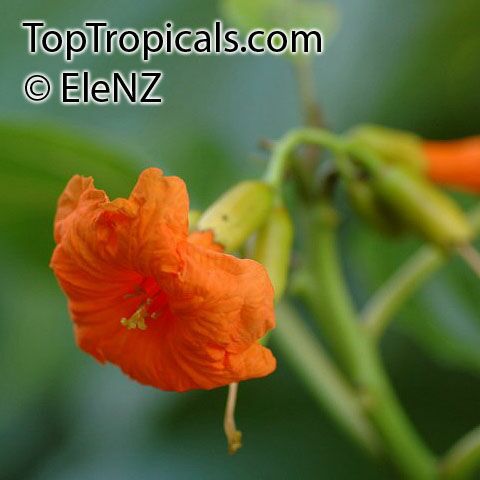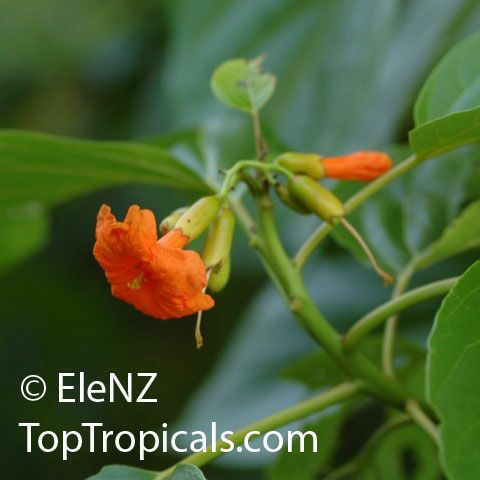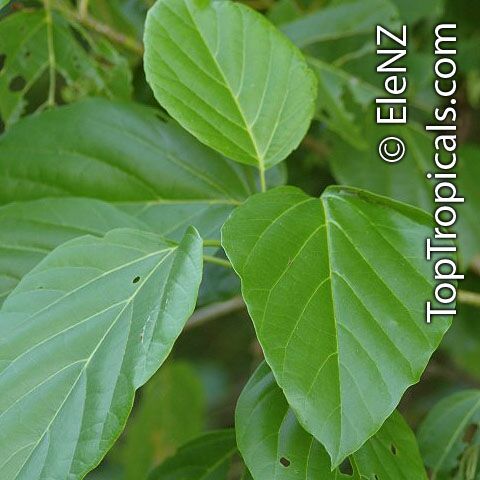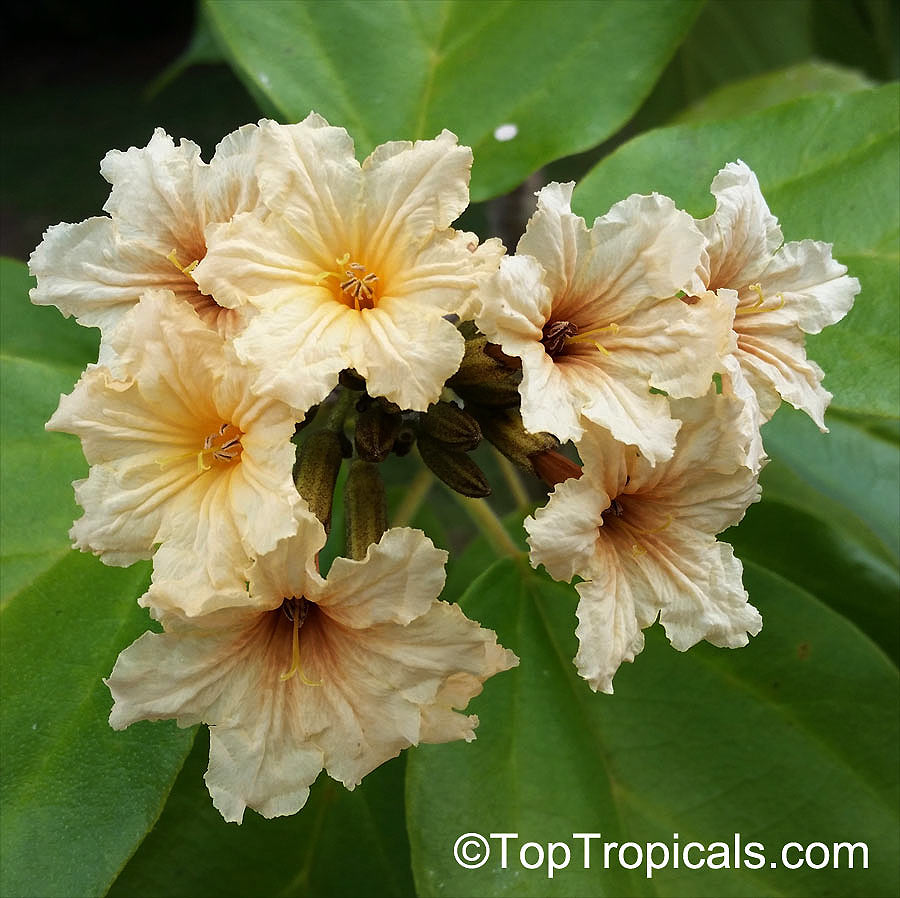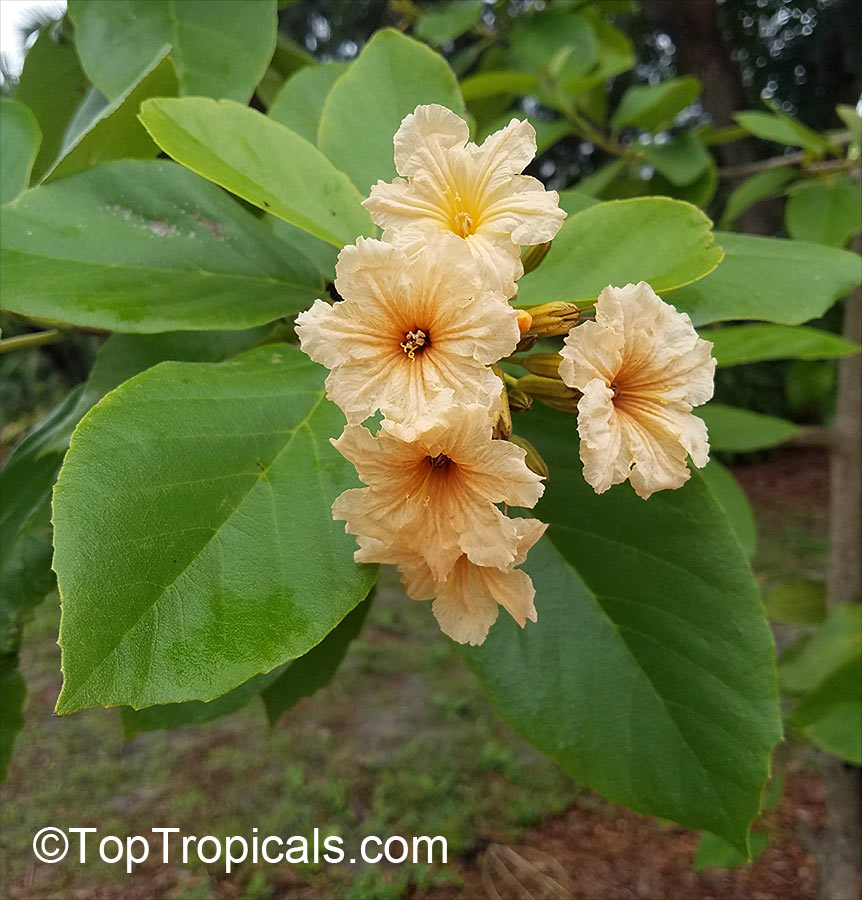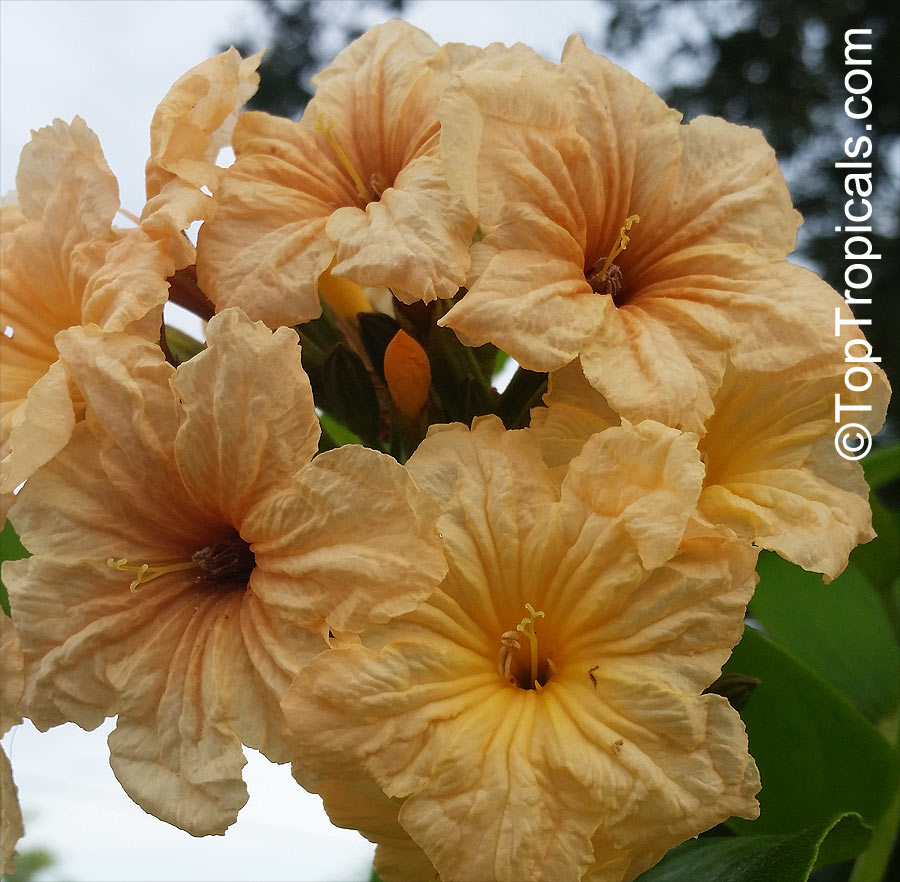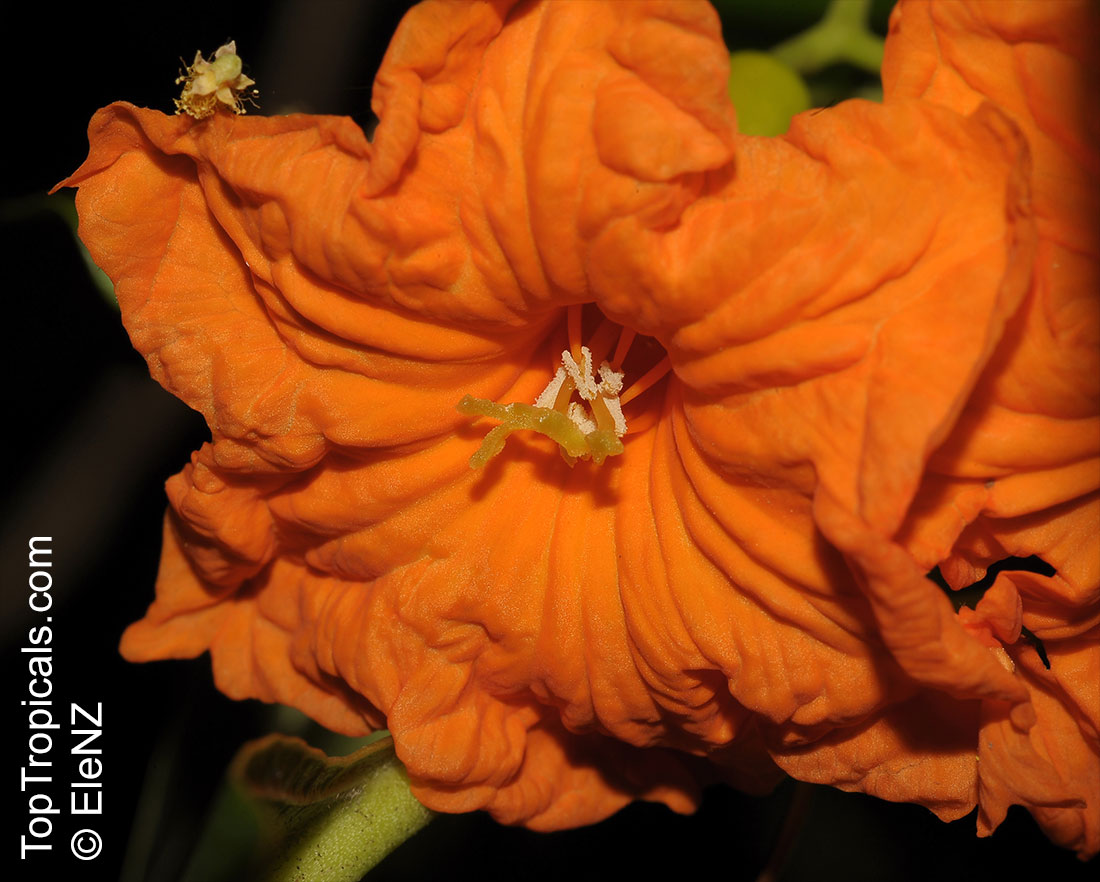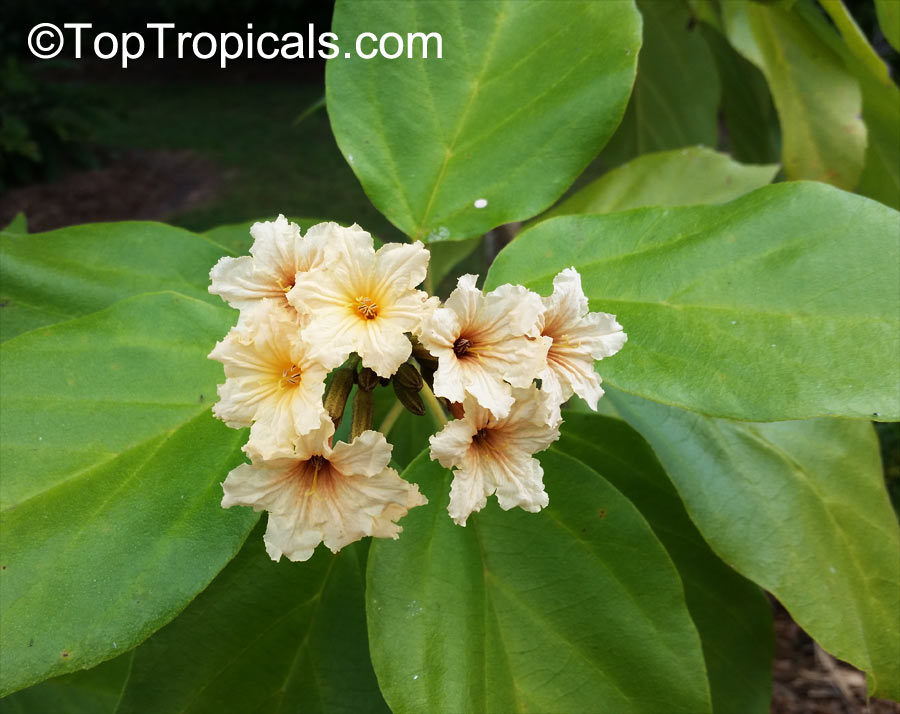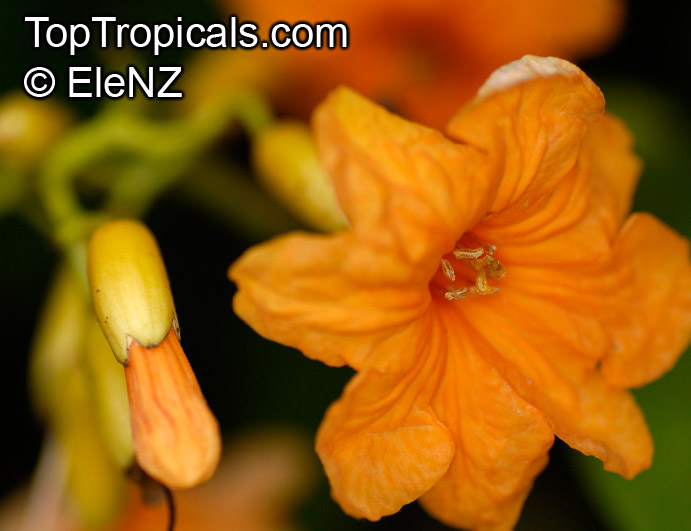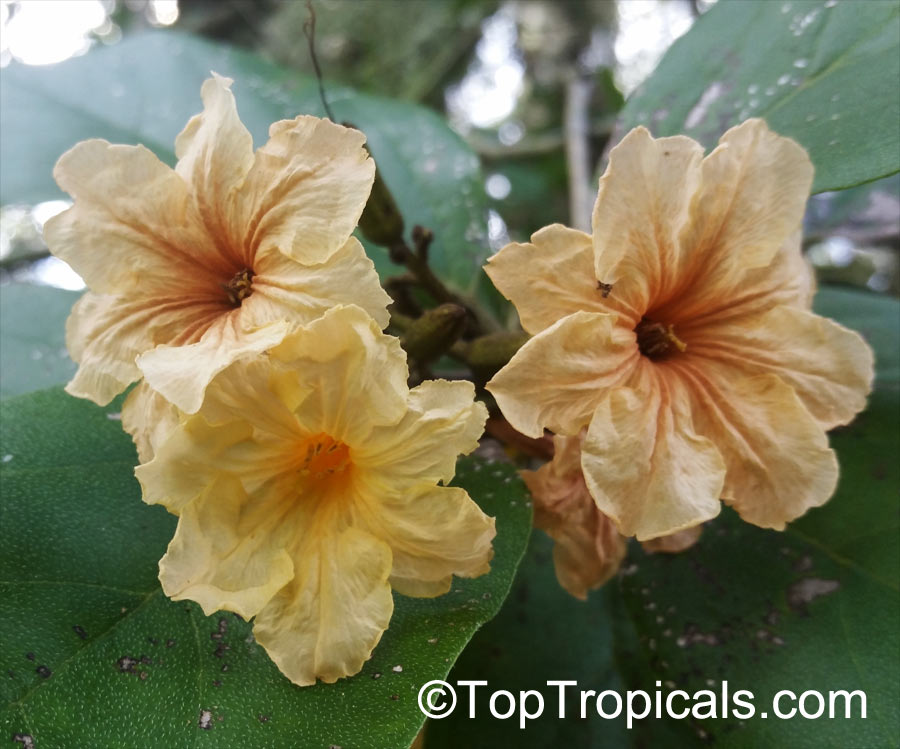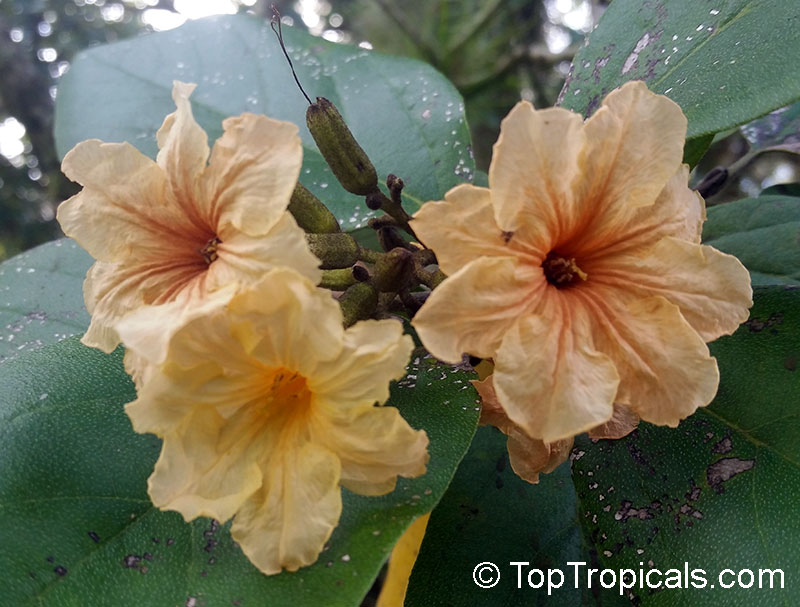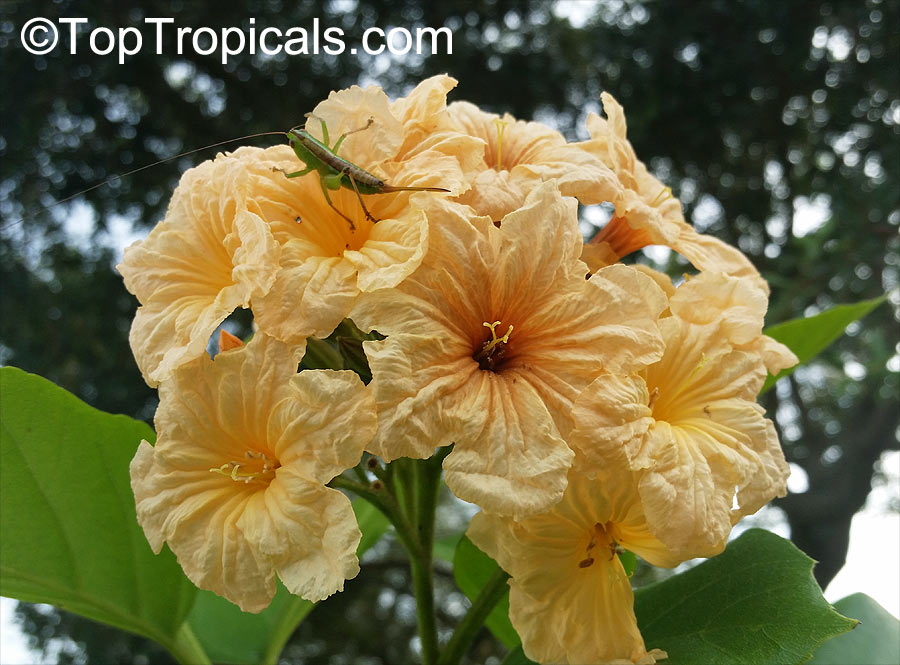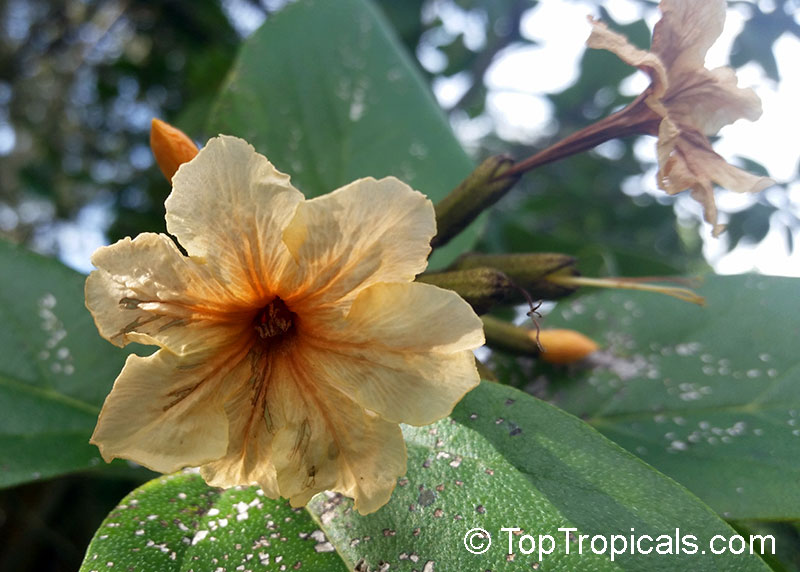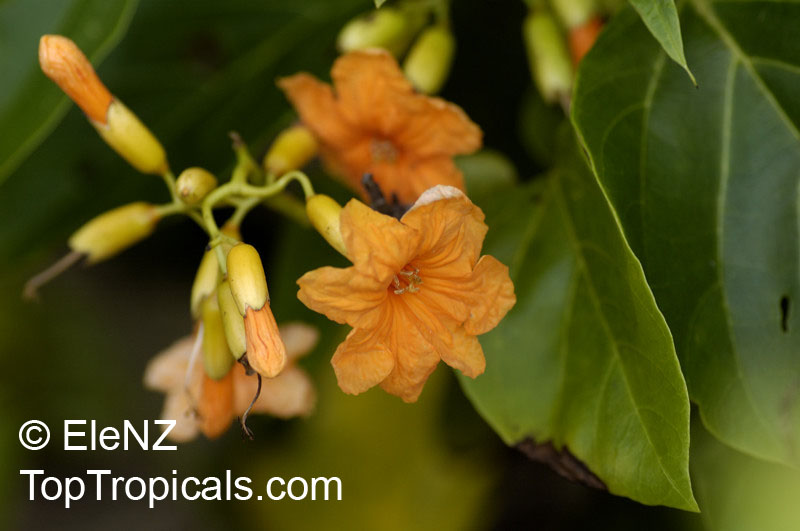Calabash - Plant Encyclopedia Results
Top Tropicals Plant Encyclopedia
| Number of plants found: 9 |
Botanical names: Amphitecna latifolia, Enallagma latifolia, Dendrosicus latifolius, Crescentia latifolia
Common names: Black Calabash, Jicarillo, Savanna Calabash
Family: Bignoniaceae
Origin: Costa Rica








Irregularly shaped tree with a bent and twisting, angular trunk. Simple, alternate ovoid leaves, thick and stiff. Waxy, glossy, and dark green, they contrast markedly with the lighter bark of the branches and twigs. Solitary flowers may be found growing amid the foliage or directly from the sides of the bare sections of the larger limbs and even the trunk. They are large, white, and composed of four thick petals fused into a bent and angular corolla tube that flares distally into a trumpet. The green calyx that covers and protects the developing flower during its early development is also fused into one piece, and it splits irregularly when the blossom finally emerges. Five long, black-anthered stamens and a central pistil are found within the perianth. Flowers are nearly present throughout the entire year. Fruits are large (4"in diameter), ovoid, indehiscent green pods with a smooth, glossy texture and an appearance similar to the fruits of the Jicaro (Crescentia alata ) tree. Inside the thin, woody skin of the pod is a white fleshy pulp that surrounds several black seeds. The white pulp and seeds of the fruit are edible. Jicarillo wood is reportedly hard and rot resistant.
Pollination: "Members of this genus are not bee pollinated - the flowers have peak nectar production at night, and you'll notice that they produce quite a lot of nectar. Bees are generally after the pollen, they would probably drown in all the nectar this species produces. The flowers are also pretty big - these are bat pollinated. The bees will certainly visit, but they are not effective transferrers of the pollen to the stigma". (By Susan Grose)
Botanical name: Amphitecna macrophylla
Common name: Bigleaf Black Calabash
Family: Bignoniaceae
Origin: Mexico, Guatemala





Botanical names: Crescentia alata, Parmentiera alata
Common names: Gourd tree, Jicaro, Morrito. Calabash Tree
Family: Bignoniaceae
Origin: Mexico, Central and South America






It is a small tree growing to 8 m tall. It has hard, cannonball-like fruit 7-10 cm diameter, that are difficult to break into. The seeds are edible and high in protein with a licorice-like sweet taste. Flowering is nocturnal and occurs on the branches and trunk throughout most of the year.
Crescentia alata is similar to Crescentia cujete
except that both fruits and flowers are smaller.
See our video about Candle Tree.
Botanical name: Crescentia cujete
Common names: Calabash Tree, Krabasi, Kalebas, Huingo
Family: Bignoniaceae
Origin: Mexico to Brazil including the Antilles








The Calabash Tree (Crescentia cujete) is a unique plant known for its yellow to orange flowers, dark green foliage, and distinctive growth habit. It is a fast-growing, evergreen tropical tree that can reach up to 25 feet tall. This plant is well-suited for USDA Zone 9-11 and can be grown in pots in colder regions. It is widely used as an ornamental in the tropics and is also wind-resistant, making it a good choice for coastal planting in seaside areas.
This plant requires full sun or partial shade and moderate watering, especially during hot seasons. Its hardy character and ethnomedical uses make it an excellent choice for gardeners looking to bring the beauty of the tropics to their own gardens.
One of the most recognizable features of the Calabash Tree is the large, round green fruit that grows directly on its branches. The tree has rough bark and simple leaves, and its flowers appear directly from nodes on the trunk and branches. It blooms at night and its fruit develops from the main trunk and limbs after pollination by bats. The fruit can reach up to 14 inches in diameter and has a hard green shell with a pulpy interior.
The pulp of the Calabash fruit has medicinal uses, including traditional treatments for respiratory problems in Suriname. The fruit also contains hydrocyanic acid, making it a purgative. The hard shells of the fruit are often used as containers for food or water, and the tree is also commonly used in Tropical American folk medicine. The Calabash Tree has some salt tolerance but cannot tolerate frost.
In addition to its ornamental qualities, the Calabash Tree is also an excellent host for epiphytes like bromeliads and orchids. With its unique appearance, versatility, and tolerance for a range of growing conditions, the Calabash Tree makes an interesting and valuable addition to any garden.
Botanical name: Monodora myristica
Common names: Calabash Nutmeg, Jamaica Nutmeg
Family: Annonaceae
Origin: West Africa










This medium to large size tree has a lush crown. Huge, oblong leaves are particularly handsome. They emerge purple and turn deep green, with metallic green underneath. It is one of the most renowned tropical species for its fragrant blooms that are unsurpassed in beauty and originality. Like festive decorations, these curious flowers dangle on long, sturdy cords, which are actually modified twigs. They abort if flower is not fertilized, or thicken and become woody if it is. The flowers are heavily waxy. Somewhat reminiscent of an orchid, the arching, yellowing calyx lobes are crisply frilled, margins edged and splotched with deep red, while the petals are paler with purplish red spots. Flowers evolve into large, woody syncarp fruit that is filled with aromatic pulp. The large, pungent seeds embedded within are used like nutmeg to flavor food, or are roasted, ground, and applied to heal wounds or to the forehead to relief headaches. Root is chewed to relieve toothaches. Beetle pollinated.
Botanical name: Monodora sp.
Common names: Monodora, Calabash Nutmeg
Family: Annonaceae
Origin: Tropical Africa











Monodora sp. is a plant native to tropical Africa with a variety of shapes and sizes. They range from large shrubs 5-10 feet tall, to a small tree 10-20 feet tall, and even sometimes reaching upwards of 20 feet as a big tree. The red, crimson, and vinous flowers are a lovely addition to any garden, as well as the yellow and orange blooms.
The Monodora sp. is an ethnomedical plant, used for centuries in many cultures for its spice or herb properties. As an added bonus it also acts as a natural attraction for butterflies, hummingbirds and many other pollinators.
This plant prefers full sun and regular water, although it is generally quite low maintenance and does well even with moderate water. It is a hardy plant that can be grown in USDA Zones 9-11. For colder regions, Monodora sp. can be grown in a pot where it has some protection from the coldest of winter weather.
All in all, the Monodora sp. is a great addition to any garden, no matter the climate or size. With its vivid flowers, ethnobotanical properties, and pollinator attracting powers, it is a great way to bring more color and life to any garden.
Botanical name: Passiflora coriacea
Common names: Wild Sweet Calabash, Bat leaved Passion Flower
Family: Passifloraceae
Origin: Central and South America







Native to Central and South America, this captivating vine or creeper is found in a variety of habitats and thrives in USDA Zones 9-11. It is a vigorous grower and will reach up to 10 feet once established.
The evergreen foliage of Passiflora coriacea is black-green in color, a striking contrast against its white and off-white flowers. The very unique blooms of this species feature an intricate design with filaments and a crown of yellow and orange and can reach up to 4 inches in size. The long petals and stamens of the flowers make them especially attractive to butterflies and hummingbirds.
This species prefers full sun and does best in regular water, although once established it will tolerate a moderate watering regime. Passiflora coriacea makes an excellent choice for growing in a pot, and can even withstand cooler temperatures in regions where freezing temperatures are common.
To ensure this plant thrives, it is important to use a container with plenty of drainage and provide moderate water and full sun. In cold regions, it is important to bring the pot indoors during winter, as temperatures below 32 F degrees can be damaging to the plant. For best results, use a good quality potting soil and a well-draining container to help protect roots from damage due to excessive moisture.
Botanical name: Passiflora maliformis
Common names: Sweet Calabash, Conch apple, Hard-shelled Passionfruit, Sweet Cup, Water Lemon
Family: Passifloraceae
Origin: Northern South America







Fast-growing vine, grows best in somewhat cooler than tropical climates. The rind is particularly hard, and tougher than most passion fruits. This species is native and common in the wild in Cuba, Puerto Rico, the Dominican Republic, Jamaica, and from Saba to Barbados and Trinidad; also Venezuela, Colombia and northern Ecuador. It is cultivated in Jamaica, Brazil and Ecuador for its fruits, and in Hawaii as an ornamental in private gardens. The fruits ripen from September to December, are light-yellow with a very hard shell, difficult to open but the seedy pulp is much enjoyed. Yellow-orange pulp is aromatically scented and flavored. In Jamaica, it is scooped from the shell and served with wine and sugar. The strained juice is excellent for making cold drinks. Snuff boxes have been made of the shell of the hard type. This species is noted for its resistance to pests and diseases that affect its relatives.
Botanical name: Cordia subcordata
Common names: Mareer, Manjak, Kerosene Tree, Snottygobbles, Glueberry, Kou Wood
Family: Boraginaceae
Origin: Eastern Africa, South Asia, Southeast Asia, Northern Australia, Pacific Islands










Cordia subcordata is a large shrub or small tree, growing from 5-10 ft tall as a shrub and between 10-20 ft as a tree. It thrives in full sun and generally prefers regular water. Moderate water during the dry season is often sufficient. It produces a profusion of 2 inch wide red, crimson, or vinous flowers that are very attractive to butterflies and hummingbirds. The flowers may also be yellow or orange. It is rated for USDA Zones 10-11.
The fruits of Cordia subcordata are ovoid and edible, usually yellow or orange when ripe. The fruits are often eaten fresh as they contain high amounts of Vitamin C, dietary fiber and other antioxidants. When ripe, the fruits are sweet and juicy. Each of the trees can produce up to 500 fruits in a season, providing a substantial harvest. The fruits can also be used to make jams and jellies. In addition, the bark, leaves and fruits of the tree are used to make traditional medicines in many cultures for various ailments and for health promotion.
The seeds are edible and have been eaten during famine. The wood of the tree is soft, durable, easily worked, and resistant to termites. It burns readily, and this led to the nickname of Kerosene Tree in Papua New Guinea. In ancient Hawaii Kou wood was used to make umeke (bowls), utensils, and umeke laau (large calabashes) because it did not change taste to food. The flowers were used to make lei, while a dye for kapa cloth and aho (fishing lines) was derived from the leaves.
Use link to repeat this search:
https://toptropicals.com/cgi-bin/garden_catalog/cat.cgi?find=Calabash&search_op=and&keyword_op=and&language=e&number=10
&no_change_lang=1&user=tt&sale=1&first=0
